FEDERAL COURT OF AUSTRALIA
Verrocchi v Direct Chemist Outlet Pty Ltd [2015] FCA 234
|
IN THE FEDERAL COURT OF AUSTRALIA |
|
|
First Applicant JACK GANCE Second Applicant | |
|
AND: |
DIRECT CHEMIST OUTLET PTY LTD (ACN 123 831 210) First Respondent IAN TAUMAN Second Respondent |
|
DATE OF ORDER: |
|
|
WHERE MADE: |
THE COURT ORDERS THAT:
1. By 4.00 pm on 27 March 2015, the parties confer and file and serve a joint minute of orders reflecting these reasons (including as to costs), or in the event of disagreement, a separate minute of order with short written submissions in support thereof.
Note: Entry of orders is dealt with in Rule 39.32 of the Federal Court Rules 2011.
|
VICTORIA DISTRICT REGISTRY |
|
|
GENERAL DIVISION |
VID 781 of 2013 |
|
BETWEEN: |
MARIO VERROCCHI First Applicant JACK GANCE Second Applicant |
|
AND: |
DIRECT CHEMIST OUTLET PTY LTD (ACN 123 831 210) First Respondent IAN TAUMAN Second Respondent |
|
JUDGE: |
MIDDLETON J |
|
DATE: |
17 MARCH 2015 |
|
PLACE: |
MELBOURNE |
REASONS FOR JUDGMENT
INTRODUCTION
1 In this proceeding the Applicants, Mr Mario Verrocchi and Mr Jack Gance, primarily bring claims for breach of s 52 of the Trade Practices Act 1974 (Cth) (‘the TPA’) and s 18 of the Australian Consumer Law (‘the ACL’) being Sch 2 to the Competition and Consumer Act 2010 (Cth) (‘the CCA’), and claims for trade mark infringement, against the Respondents, Direct Chemist Outlet Pty Ltd (‘DCO’) and Mr Ian Tauman.
2 Specifically, the Applicants (trading as Chemist Warehouse) primarily allege that since 26 May 2006:
(a) the Respondents have adopted a get-up for their stores, catalogues and website, in association with the descriptive and non-distinctive name “Direct Chemist Outlet” which has caused and is likely to cause consumers to believe that the Respondents’ pharmacies are either those of the Applicants, or are associated or affiliated with the Applicants’ pharmacy chain;
(b) the Respondents have failed to take any step to adequately distinguish themselves from the Applicants’ business, and have intentionally copied various visual attributes of the Applicants’ marketing and business so as to further consumers’ misconception;
(c) as a result of the Respondents’ conduct, consumers have been or are likely to have been misled or deceived and subject to false representations that, when the consumers receive a DCO catalogue, attend a DCO store, or visit the DCO website, they are either engaged in dealing with Chemist Warehouse or a pharmacy associated with that chain; and
(d) the Respondents have infringed the Applicants’ registered trade mark which contains the slogan “Is this Australia’s Cheapest Chemist?”.
3 Other claims are brought by the Applicants pursuant to provisions of the TPA and CCA, and passing off, but the primary basis of the claims of the Applicants is as set out above.
4 In the circumstances of this proceeding, the reliance by the Applicants on s 53 of the TPA and s 29 of the ACL, and the tort of passing off, add nothing to the basis on which the Applicants could obtain relief. My findings in relation to s 52 of the TPA and s 18 of the ACL will equally determine the claims under the other statutory provisions and in relation to the passing off claim.
5 This proceeding primarily raises issues concerned with the trade indicia of retail stores (in conjunction with the use of catalogues, advertising materials and websites) and the extent to which one trader may effectively obtain a form of de facto monopoly over such indicia.
6 At the outset I make some observations.
7 First, I accept that branding, as a concept, is of great importance and significance in a business model. Where colour is used as a key branding element, it is not to be regarded as a trivial or insignificant component of the brand concept. Consumers will often quickly register the colour or colours used in branding, and will often retain a conscious or subconscious recognition and association of a colour or colours with a particular brand. From the business’s perspective, any visual impact of its branding (including colour) is often intentional and important.
8 In this proceeding, the competing parties make heavy use of colour in the branding and promotion of their stores. However, as the Applicants correctly contended, it is important not to “over-intellectualize the likely analysis of the consumer” in undertaking the relevant legal assessment of the possible consumer responses to the branding of competitors. Further, I am mindful that the relevant consumer’s likely analysis would not involve the viewing and side-by-side comparison of all the photographs put into evidence in this proceeding; rather the consumer’s analysis will be governed by an overall impression of colours in combination with other branding features, including the relevant (and dominant) logo in situ.
9 While colours are generally useful in branding for ornamentation or decoration, some colours are known to perform a specific marketing function. For example, the colour yellow provides high visibility, and is therefore used in street and roadwork signs. When used on storefronts, it can similarly attract attention to the store. Justice Mansfield in Philmac Pty Ltd v Registrar of Trade Marks (2002) 126 FCR 525 noted at [54] that:
…a trader might legitimately choose a colour for its practical utility. That is, the colour may be a feature of a product that serves to improve the functionality or durability of the product. The function of visibility is, for example, served by the colour yellow; heat absorption by the colour black; light reflection by the colour white; military camouflage by a combination of khaki, brown and green. …
10 The external get-up of Chemist Warehouse is, as submitted by the Applicants, “highly prominent, loud and garish and prone to be noticed by potential consumers… especially in the context of the busy high street and shopping centre environments in which the stores trade”.
11 Examples of predominantly yellow storefronts include the following:
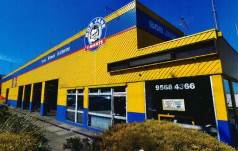
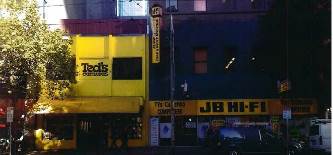
12 The colour yellow can also be used to denote a value proposition. A number of discount retailers (including discount chemists) use that colour as part of their storefront and many retailers use yellow to promote sales. The prominent, loud and garish use of yellow imparts the look and feel of “cheapness”, or heavily discounted goods or services. One such example is shown below:
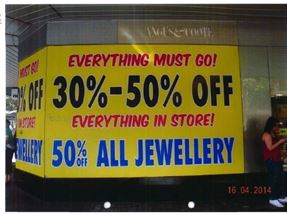
13 Examples of discount chemists which employ a predominant use of yellow on their storefronts include the following:
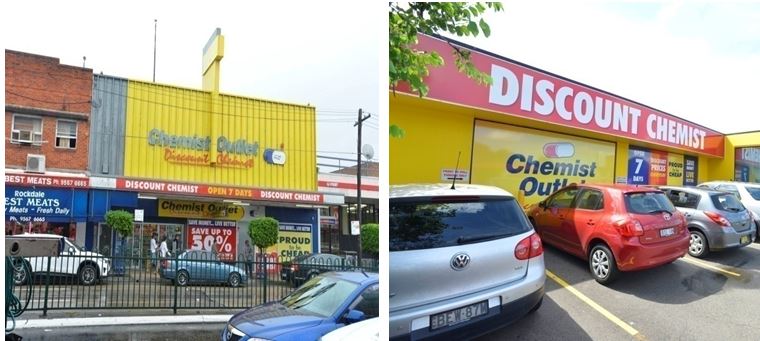
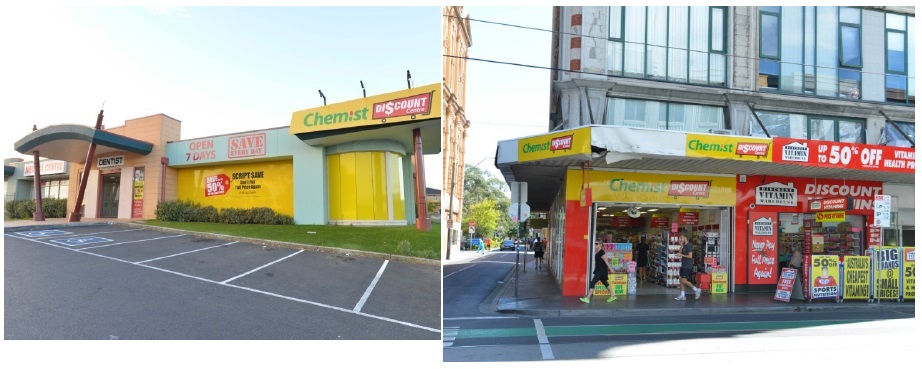
14 The Applicants contended that the Respondents do not need to use yellow to operate a successful discount chemist. While this may be true, the Respondents may wish to use this colour to take advantage of the two attributes mentioned above, namely visibility and the discount value proposition, which are both understandably desirable attributes for any discount store, including a chemist.
15 Secondly, during the hearing an inspection was undertaken of certain stores the subject of this proceeding in order to assist the Court in understanding the evidence and the photographic evidence in particular. Section 54 of the Evidence Act 1995 (Cth) enables the court to draw any reasonable inference from what is seen during an inspection, but the parties agreed that the object of the inspection was as I have just indicated. During the inspection I observed that, as is common experience, a customer’s perception of the look or get-up of a store depends on the direction from which one approaches or views a store. For example, passing a store in a car, or from across the road, gives a quite different impression from that when one views a store from close up, or approaches a store (say, from an adjacent store) and therefore only sees the windows and entrance, and not the parts of the building near the roof-line.
16 Thirdly, it is important to recall that confusion of consumers or potential consumers is not enough to establish liability under the TPA or the ACL. A consumer may recognise a similarity in the range of colours used by both the Applicants and Respondents in their branding, the extent of which will depend on the particular consumer’s familiarity with Applicants’ or the Respondents’ stores, catalogues or websites. Further, most retail catalogues (whether for pharmacies or otherwise) have essentially common features, and are produced to show the breadth of product range and to solicit customers (in the case of discount chemists, by drawing attention to low priced or discounted items offered for sale). There is no distinctive consistency of appearance in either of the parties’ catalogues. Further, the websites of the parties are quite different, and the appearance of the Applicants’ website varied substantially over time. The main focus of this proceeding is upon the stores, and their external get-up in particular. Admittedly, reference is made in the Chemist Warehouse catalogues and website to the Chemist Warehouse stores, but not by reference to the whole of the get-up of the Chemist Warehouse store as relied upon by the Applicants.
17 Fourthly, the Respondents undoubtedly copied many of the ideas and concepts of the Applicants, including some elements of the get-up and aspects of store display. While the Respondents liked and used aspects of the Applicants’ marketing concept, I have reached the view that they did not do so with an intention to mislead or deceive consumers, or to pass off their stores as those of (or associated with) the Applicants, nor did they adopt those elements uniformly. Further, the Respondents in my view sufficiently distinguished their chemists from those of the Applicants.
18 Fifthly, if not for my ultimate finding in this proceeding, it may have been necessary to make findings as to the reputation of Chemist Warehouse on a geographical or territorial basis. The existence or strength of any reputation that Chemist Warehouse had at a particular point in time would inevitably vary between geographical areas, as it commenced operation and promotion in certain areas much later than when it first commenced operating using the get-up relied upon in this proceeding.
19 If I were to consider this using a geographical analysis, the Applicants would still need to establish that it was the Respondents’ actions that caused any likelihood of deception within each geographic area. This may mean that if the Applicants had set up a store in a particular area already (or previously) occupied by a DCO store, then the Applicants may not rightly complain of any “confusion” in that area being caused by the Respondents. The Applicants did not adduce any specific evidence directed to establishing reputation on a geographical basis.
20 Further, if a geographical approach was taken, the Court may have needed to restrict relief to particular areas, or to modify the relief granted. The Court would require evidence of the current position at the date of trial, so as to determine the appropriate injunctive relief to grant in order to be fair to each party and to avoid stifling lawful competition. After all, injunctive relief should be limited to what is necessary in the circumstances of the particular case: see, eg, Campomar Sociedad Limitada v Nike International Ltd (2000) 202 CLR 45 (‘Campomar’) at [111].
21 Submissions were also put before the Court on the question of determining the relevant date of the commencement of the impugned conduct where a respondent gradually expands its business into new districts or geographic area in which an applicant operates. In addition to the reasoning of Yates J in Optical 88 Ltd v Optical 88 Pty Ltd (No 2) (2010) 275 ALR 526 (‘Optical 88’), the Applicants made reference to some observations of Allsop J (as he then was) in Mobileworld Communications Pty Ltd v Q & Q Global Enterprise (2004) 61 IPR 98 at [125] and of Moore J in Toddler Kindy Gymbaroo Pty Ltd v Gymboree Pty Ltd (2000) 100 FCR 166 at [129].
22 The Applicants’ “primary submission” was that the date for assessing conduct should be 26 May 2006, when the impugned conduct began. However, the Applicants submitted that it may be more appropriate to consider the reputation of the Applicants as at the date that the Respondents commenced business in a new area, given the localised nature of the pharmacy operators and marketing.
23 The Applicants in their submissions (seemingly in the alternate) also invited the Court to take a geographical approach and treat the relevant date for assessing the Applicants’ reputation as at the opening of each DCO store, unless the new DCO store opened relatively close to an existing store.
24 However, if the Applicants and Respondents were concurrently trading and building independent reputations in separate areas, it may have been the case that it was not the Respondents’ conduct that was misleading or deceptive at that later time.
25 For example, the Lalor DCO store opened in 2014, well after 26 May 2006. Both parties had advanced their own reputations by that time. What is the Court to conclude is the position of the competing parties in that particular area and at that particular time? It is to be recalled that since 26 May 2006 both businesses involved in this proceeding have increased their respective exposure to the relevant consumers by opening many new stores. There has been co-existence in the market place for approximately eight years prior to litigation commencing. Further, stores have opened in numerous locations, and Chemist Warehouse stores have opened in close proximity to existing DCO stores (as in the case of the Warrnambool store, for example).
26 In any event, on the basis of the view I have reached that DCO stores adequately distinguish themselves from Chemist Warehouse stores so as not to mislead consumers, even if one took the later date in Lalor (for example), this would not result in liability attaching to the Respondents. The relevant consumers in Lalor (for example) would not be misled as they would appreciate the difference between the two pharmacy outlets. There is also evidence to suggest that in the years between 26 May 2006 and 2014, the Applicants made even more prominent use of the Chemist Warehouse logo so as to distinguish itself from DCO.
27 I have come to the view that in this proceeding, even if the Court was to take a geographical approach as suggested by the Applicants, and assess Chemist Warehouse’s reputation in each particular area as at the date on which a DCO store opened in that area, the result would not be any different.
28 Sixthly, the Applicants did not seek to rely upon any trade mark for the overall get-up of their stores, or the branding of their catalogues or website. Instead, the Applicants rely upon their claims of misleading or deceptive conduct to obtain relief restraining the Respondents from adopting a get-up (and colour scheme in particular) for their stores, catalogues and website.
29 Seventhly, as the Applicants accept, this is not a proceeding concerned with a single colour (yellow), but the use of a palette of three primary colours (yellow, blue and red), in combination with a red logo with white text, and the use of descriptive discount slogans.
30 In the context of the misleading or deceptive conduct claim (and passing off), the Applicants rely in part on the relevant consumers having come to recognise or appreciate that those particular visual branding devices have become associated with the Applicants’ business.
31 Normally the trade indicia of the stores would need to be somehow distinctive so that consumers would come to associate them with the Chemist Warehouse business — if it were the same or similar as other retail outlets it is difficult to see how the relevant consumers could come to associate the trade indicia with a particular trader.
32 In this proceeding, the evidence discloses insufficient uniformity in the visual branding devices relied upon by the Applicants to support a claim for misleading or deceptive conduct against the Respondents. There is no sufficiently common identity in the design and layout to give rise to an unusual or distinctive store get-up (or catalogue or website design) associated with the Applicants. In addition, the Respondents have sufficiently distinguished the trade indicia of their stores, so that the logo, colours and physical appearance of their stores, catalogues and website, would not mislead or deceive, or be likely to mislead or deceive, the relevant consumers.
33 I make one specific comment on the Applicants’ reliance on the cumulative reputational effect of the get-up of the stores, catalogues and website. There was no actual or intended uniformity between these three forms of promotion by the Applicants; the use of colour, font and layout differs materially between them. The one constant was the Chemist Warehouse logo, which was a uniform and primary focus in all forms of promotion. No Chemist Warehouse store would have been opened without the prominent use of the vibrant red logo, which includes the words “Chemist Warehouse”, and it was this logo which communicated the Applicants’ brand to the relevant consumers.
34 Finally, if I had found that the exteriors of Chemist Warehouse and DCO stores were sufficiently similar, the difference in their interiors would not mitigate the Respondents’ liability. However, it may have been relevant as to the relief the Court would grant to the Applicants.
35 Whilst a consumer may intend to visit a particular pharmacy, he or she is ultimately concerned with purchasing a particular product, and possibly at a discounted price. Once inside the discount pharmacy, even if the consumer discovers that he or she was misled as to the brand by the exterior get-up, the consumer is likely to proceed to purchase the desired product.
36 As will be apparent, I have reached the view that the interiors of the parties’ stores are sufficiently different, to the extent that consumers would not be misled or deceived on the basis pleaded by the Applicants in this proceeding. Nevertheless, if the Respondents had misled consumers only by their storefront get-up, I would have concluded that such customers would have already been enticed into the “marketing web” of the Respondents.
37 Having made these observations, I now briefly outline the relief sought by the Applicants.
38 The Applicants seek orders restraining the Respondents from using a get-up on stores, catalogues and websites in the conduct of their discount pharmacy business which is deceptively similar or substantially identical to the Applicants’ stores, catalogues and websites. More particularly, the Applicants towards the end of the hearing sought orders in the following form:
Each of the Respondents, whether by themselves, their employees, servants, agents, representatives, licensees or otherwise be restrained from:
(a) displaying an external get up on any pharmacy that is substantially identical, or deceptively similar, to the external get up of either of the Chemist Warehouse pharmacies depicted in Annexure A;
(b) publishing or distributing catalogues for any pharmacy displaying a get up that is substantially identical, or deceptively similar, to any of the Chemist Warehouse catalogues depicted in Annexure B; or
(c) publishing a website displaying a get up that is substantially identical, or deceptively similar, to the Chemist Warehouse website depicted in Annexure C;
(d) otherwise marketing a pharmacy with a get up predominantly comprising the background colours red, yellow and blue and a red logo with white writing.
(e) using a sign that is substantially identical, or deceptively similar, to Australian Registered Trade Mark No 1195650, including a sign comprising the words “Who is? Australia’s Cheapest Chemist”, as a trade mark in respect of any:
(i) retailing, online retailing or mail ordering services, relating to pharmacies;
(ii) medical, hygienic or beauty care services, relating to pharmacies and being pharmacy advisory and pharmacy dispensary services.
…
39 The Annexures referred to above included examples of Chemist Warehouse stores, catalogues and website.
40 There are some difficulties with that form of order in this proceeding. This is because the evidence in this proceeding shows that, for example in relation to the storefronts, their appearance since 26 May 2006 has not constituted a uniform appearance that could be said to comprise the get-up of the Applicants at any relevant date. At best there was some consistency in the use of bright and primary colours (including yellow), and the “Chemist Warehouse” logo. The various DCO stores also lacked a sufficiently consistent appearance, so that it would be difficult to precisely identify which DCO stores were deceptively similar to the two storefront examples annexed to the Applicants’ proposed orders, assuming those examples were indeed the “best” depiction of the Applicants’ storefront get-up. Similar issues arise in relation to the catalogues and the website.
41 Just as goods of different manufacturers may innocuously bear some resemblance to each other, so too will retail stores and the use of colours that have a functional element. Where such a legitimate resemblance occurs, then marks, labels and other unique branding will be significant in distinguishing competitors. Whilst there is no evidence in this proceeding on this topic, I perceive that consumers are alive to imitation and, if important to their own purchase decision, will seek out the distinguishing branding. In the discount chemist context, the consumer is likely to be interested in obtaining a cheaper item than at traditional chemists. This is not to say a consumer may not be concerned about the particular brand of discount chemist from which he or she purchases, or its associations with other businesses; but, the consumer is primarily concerned with the price or discount.
42 In making the above comment, I am mindful that it is sufficient if some form of association or connection is conveyed by the impugned conduct, although the precise form of association or connection may not be able to be articulated or identified: see, eg, Telstra Corp Ltd v Royal Sun Alliance Insurance Australia Ltd (2003) 57 IPR 453 at [76] and see generally Pacific Dunlop Ltd v Hogan (1989) 23 FCR 553 (‘Pacific Dunlop’).
43 Finally, the Applicants sought damages for loss caused by the Respondents’ conduct.
44 The Respondents, by cross claim challenge the validity of the Applicants’ trade mark pursuant to s 88 of the Trade Marks Act 1995 (Cth) (‘the TM Act’).
45 I ordered that issues of liability and quantum were to be heard separately. These reasons are solely concerned with liability.
THE APPLICANTS
46 Messrs Verrocchi and Gance are both registered pharmacists. Together with Messrs Samuel and Damien Gance they began developing their discount pharmacy concept from late 1999 and launched their first discount pharmacy store called “Chemi Stop” in Footscray, Victoria on 15 June 2000. The name “Chemi Stop” was subsequently changed to “Chemist Warehouse” in 2002.
47 The Applicants license the use of the Chemist Warehouse trade marks, get-up, slogans and associated intellectual property rights to each of the proprietors of retail pharmacies that trade under the name “Chemist Warehouse” across Australia.
48 As at 31 January 2014, there were over 250 Chemist Warehouse stores across all states and territories in Australia. As at March 2014, the Applicants had a proprietary interest, either as sole traders, together with one another or in partnership, with other pharmacists, in 68 of those pharmacies.
THE RESPONDENTS
49 DCO was formed on 7 February 2007 and Mr Tauman is a director and secretary of DCO.
50 Mr Tauman licenses the right to use the name and trade marks incorporating the words “Direct Chemist Outlet” to each of the pharmacies within the DCO group. He also assists the stores with operations as necessary but ultimately the operation of each store is a matter for the individual proprietors or pharmacist in charge.
51 DCO is responsible for marketing, merchandising and category management of the DCO pharmacies. The stores are operated by the licensees who are responsible for human resources, general buying and operation of the store.
52 The first DCO store opened in Werribee on or around 26 May 2006, and as at 28 April 2014, there were 24 stores in Victoria, Queensland and New South Wales.
The WITNESSES
53 The Applicants called evidence from the following principal witnesses:
(a) Mr Mario Verrocchi;
(b) Mr Damien Gance, the nephew of Mr Jack Gance, and proprietor of five Chemist Warehouse stores, and Group Commercial Manager of the Chemist Warehouse group;
(c) Mr Theo Kassahun, a former Retail Manager at Mount Waverley DCO;
(d) Ms Ashlen Arevyan, a former Dispensary Technician at Mount Waverley DCO; and
(e) Mr Ian Carroll, a sign writer who had been retained by Chemist Warehouse to paint signage on its stores.
54 The Respondents called evidence from the following principal witnesses:
(a) Mr Ian Tauman; and
(b) Ms Jenna Rohr, Group Co-ordinator of DCO.
LEGAL PRINCIPLES
The ACL / TPA
55 Section 52 of the TPA, now s 18 of Sch 2 of the CCA provides that a corporation or person must not, in trade or commerce, engage in conduct that is misleading or deceptive or is likely to mislead or deceive.
56 As I have indicated, these provisions are the primary focus of the claims of the Applicants, although they did place reliance on other provisions in their pleadings. Nevertheless, in view of the approach I have taken, it is convenient to focus on the misleading or deceptive conduct provisions mentioned above.
57 Whilst there is a great deal of practical coincidence between the tort of passing off and contravention of the misleading or deceptive conduct provisions, the two claims have distinct premises. The former is designed to protect the goodwill or reputation of traders and the latter is designed to protect consumers. Nonetheless, the Applicants acknowledge that if they fail to establish a breach of the TPA or ACL, they will also fail to establish passing off.
General principles - misleading or deceptive conduct provisions
58 There is no dispute that the principles applicable to s 52 of the TPA and s 18 of the ACL are the same. The applicable principles relevant to a case regarding the alleged taking of the trade indicia (including a trading name) of a trade rival are set out in S & I Publishing Pty Ltd v Australian Surf Life Saver Pty Ltd (1998) 88 FCR 354; (‘S & I Publishing’) at FCR 362–3 per Hill, Nicholson and Emmett JJ, adopting with approval what Hill J said in Equity Access Pty Ltd v Westpac Banking Corporation (1989) 16 IPR 431 at 440-441. The relevant principles were restated in S & I Publishing as follows:
1. There will be no contravention of s 52 unless the error or misconception which occurs results from the conduct of the corporation and not from other circumstances for which the corporation is not responsible.
2. Conduct will be misleading and deceptive if it leads into error.
3. Conduct will be likely to mislead or deceive if there is a “real or not remote chance or possibility” of misleading or deceiving regardless of whether it is less or more than 50 per cent.
4. Conduct causing confusion or uncertainty in the sense that members of the public might have cause to wonder whether the two products or services might have come from the same source is not necessarily misleading and deceptive conduct.
5. In a case such as the present, an applicant must establish that it has acquired the relevant reputation in the name or get-up such that the name or get-up has become distinctive of the applicant’s business or products.
6. Conduct may be misleading or deceptive or likely to mislead or deceive notwithstanding that the corporation said to engage in that conduct acted honestly and reasonably and did not intend to mislead or deceive. Logically, a finding that conduct had been intentionally engaged upon will be irrelevant in determining whether that conduct is misleading or deceptive. It may perhaps be imagined that conduct engaged upon with the intent to mislead or deceive may fail in its purpose and not be found misleading or deceptive. Nevertheless, where the intention to mislead or deceive is found, it logically would be likely that a court would more easily find that the conduct was misleading or deceptive.
7. In many cases it will be necessary to consider the class of persons to whom the representation was directed...
8. There is no proposition of law to the effect that intervention from erroneous assumption between conduct and misconception destroys the necessary chain of causation with the consequence that the conduct cannot be regarded as likely to mislead or deceive.
9. The test of whether conduct is misleading or deceptive or likely to mislead or deceive is an objective one for the court to determine. It is ultimately a question of fact.
(citations omitted)
59 Justice Greenwood (with whom Tracey J agreed) in Peter Bodum A/S v DKSH Australia Pty Ltd (2011) 280 ALR 639 (‘Bodum’) identified other principles to be applied under s 52 of the TPA in the context of a trade indicia (as opposed to a trade name) case, as follows (from [202]-[209]):
[202] …[A] rival trader is entitled to enter the market and copy precisely the product of another and seek to take some of its market share (in the absence of any infringement of a formal intellectual property right), so long as the rival does not mislead or deceive the public or pretend, by conduct, that its goods are the goods of another…
[203] Whether impugned conduct conveys the making of a representation is a question of fact to be determined having regard to all the contextual circumstances within which something was said or done. When that assessment is being made in the context of conduct said to involve representations to the public at large (or a section of the public) such as prospective retail buyers of a product sold by a respondent rival trader, s 52 must be regarded as contemplating the effect of the impugned conduct on reasonable members of the class of prospective buyers or ordinary members of that class…[S]o far as the remarks relate to deception:
The usual manner in which ordinary people behave must be the test of what … deception may be expected. Potential buyers of goods are not to be credited with any high perception or habitual caution. On the other hand, exceptional carelessness or stupidity may be disregarded. The course of business and the way in which the particular class of goods are sold gives, it may be said, the setting, and the habits and observation of men [and women] considered in the mass affords the standard.
[emphasis added]
[204] In order to test whether a misconception has arisen or might arise among members of the relevant cohort by reason of the impugned conduct, the inquiry is to be made notionally of the hypothetical individual excluding “assumptions by persons whose reactions are extreme or fanciful”…The question is “whether the misconceptions, or deceptions, alleged to arise, or to be likely to arise, are properly to be attributable to the ordinary and reasonable members of the class of prospective purchasers”…The issue is not whether the impugned conduct simply causes confusion or wonderment but whether the conduct is or is likely to mislead or deceive.
[205 …In determining whether a contravention of s 52 has occurred, the focus of the inquiry is whether a not insignificant number within the class or cohort have been misled or deceived or are likely to be misled or deceived by the respondent’s alleged conduct, whether in fact or by inference...
…
[210] In assessing the character of the conduct in question, against the background of all of the contextual circumstances, conduct which misleads a consumer such that he or she opens negotiations or invites approaches under some mistaken impression of a trader’s connection or affiliation with another, may be engaging in misleading or deceptive conduct even if the true position emerges before the transaction is concluded.
(citations omitted and emphasis in original)
60 In SAP Australia Pty Ltd v Sapient Australia Pty Ltd (1999) 169 ALR 1; (1999) 48 IPR 593 at [51], French, Heerey and Lindgren JJ reiterated that misleading or deceptive conduct in trade or commerce is not limited to conduct which induces or is likely to induce entry into a transaction but may include an inducement to open negotiations or invite approaches, even if the true position emerges before the transaction is concluded.
61 Further, in ACCC v TPG Internet Pty Ltd (2013) 250 CLR 640, the High Court noted that:
[50] It has long been recognised that a contravention of s 52 of the TPA may occur, not only when a contract has been concluded under the influence of a misleading advertisement, but also at the point where members of the target audience have been enticed into “the marketing web” by an erroneous belief engendered by an advertiser, even if the consumer may come to appreciate the true position before a transaction is concluded.
(footnotes omitted)
62 In considering whether consumers are likely to be misled or deceived, it is necessary to consider what was said and done against the background of all surrounding circumstances. These include:
(a) the strength of the applicant’s reputation, and the extent of distribution of its products;
(b) the strength of the respondent’s reputation, and the extent to which the respondent has undertaken any advertising of its product;
(c) the nature and extent of the differences between the products, including whether the products are directly competing;
(d) the circumstances in which the products are offered to the public; and
(e) whether the respondent has copied the applicant’s product or has intentionally adopted prominent features and characteristics of the applicant’s product.
63 The present case involves the adoption of trade indicia, rather than a trading name. Australian courts have recognised that a trader may establish a reputation in trade indicia other than names and logos, which may be protected without registration as a trade mark: Cadbury Schweppes Pty Ltd v Darrell Lea Chocolate Shops Pty Ltd (2007) 159 FCR 397 (‘the Cadbury Appeal’) at [97].
64 As I have said, colour schemes may play an important role in the marketing of a product or service.
65 In Red Bull Australia Pty Ltd v Sydneywide Distributors Pty Ltd (2001) 53 IPR 481 (‘Red Bull’) the respondents were found to have engaged in passing off and misleading or deceptive conduct by importing and selling a new energy drink which adopted the so-called “total imagery” of the applicants’ Red Bull energy drink (apart from its name). In so finding, Conti J held (at [55]) that:
…Colour schemes also constitute brand elements, colour being one of the most significant components of the get-up that attracts consumer attention, and being a central method of communication which can become part of a corporate supplier’s signature; instances cited by Dr Beaton include Kodak’s use of gold, black and red, Cadbury’s purple and Shell’s yellow and red. Ms Strachan responded that such entities have been using those respective colours over decades, and have operated in markets involving few competitors, and in the case of Shell for instance, the connection is not just the yellow colour but a yellow shell graphic; Dr Beaton rejoined that once attention is attracted to a product, the colour with which it is associated continues to have an effect in enhancing the way consumers comprehend and elaborate brand meaning in their minds; he cited advertising research to the effect that colour is central to brand recognition, and posited that achievement of recognition correlates strongly with probability of purchase; while he would accept that advertisement or package recognition does not necessarily cause propensity to purchase, the published research he cites constitutes important empirical observation which sheds light on the value of maximising the communication power of printed material, such as advertising and packaging.
66 Justice Conti recognised that the reputation may be distinct from the trading name associated with it. In Red Bull his Honour held (at [61]) that “Colour and colour combinations, particularly of cans such as those of the 250 ml size here involved, tends to attract attention before brand names embossed thereon”. Justice Conti determined (at [65]) that:
…Particularly in such product contexts, sufficient similarities of get-up may conceivably relate to elements of colour, shape and size, and thus to the existence of passing off, irrespective of the use by the competitor of a different brand name.
67 Further, there is no need to identify an exclusive reputation.
68 The Full Court in the Cadbury Appeal held that, for the purposes of the misleading or deceptive conduct provisions, there is no requirement that the applicant establish an exclusive reputation. The Full Court said at [97]–[99]:
[97] Both in the context of Part V of the Trade Practices Act and the common law tort of passing off, trade indicia other than names and logos can become associated with a particular trader, such that a use by another trader could give rise to misleading or deceptive conduct or passing off. If particular branding elements used by a trader have been identified in a special way with that trader in the minds of the members of the public, there may be misleading or deceptive conduct by reason of the appropriation of those particular branding elements by another trader.
[98] There is an overlap between causes of action arising under Part V of the Trade Practices Act and the common law tort of passing off. However, the causes of action have distinct origins and the purposes and interests that both bodies of law primarily protect are contrasting. Passing off protects a right of property in business or goodwill whereas Part V is concerned with consumer protection. Part V is not restricted by common law principles relating to passing off and provides wider protection than passing off.
[99] Whether or not there is a requirement for some exclusive reputation as an element in the common law tort of passing off, there is no such requirement in relation to Part V of the Trade Practices Act. The question is not whether an applicant has shown a sufficient reputation in a particular get-up or name. The question is whether the use of the particular get-up or name by an alleged wrongdoer in relation to his product is likely to mislead or deceive persons familiar with the claimant’s product to believe that the two products are associated, having regard to the state of the knowledge of consumers in Australia of the claimant’s product.
69 Once a trader has established that it has developed a secondary reputation in its trade indicia, the adoption of those indicia by another trader will be misleading or deceptive unless the rival trader can show that it has adequately distinguished its goods or services.
70 In Reckitt & Colman, Lord Oliver articulated the relevant test (at 15):
In the end, the question comes down not to whether the respondents are entitled to a monopoly in the sale of lemon juice in natural-size lemon-shaped containers but whether the appellants, in deliberately adopting, out of all the many possible shapes of container, a container having the most immediately striking feature of the respondents’ get-up, have taken sufficient steps to distinguish their product from that of the respondents. As Romer LJ observed in Payton & Co v Snelling, Lampard & Co (1900) 17 RPC 48 at 56:
When one person has used certain leading features, though common to the trade, if another person is going to put goods on the market, having the same leading features, he should take extra care by the distinguishing features he is going to put on his goods, to see that the goods can be really distinguished...
71 A similar approach was adopted by Burchett J (Hill and Branson JJ agreeing) in Koninklijke Philips Electronics NV v Remington Products Australia Pty Ltd (2000) 100 FCR 90 at [42], who held that “in view of the similarity” of the products in that case, “it was incumbent upon…[the respondent] to distinguish” its product from the extant rival product.
72 In Kettle Chip Co Pty Ltd v Apand Pty Ltd (1993) 46 FCR 152, Burchett J at first instance held (at 164) that once a trader has adopted a get-up closely resembling that of another trader’s product, even if it acted honestly in doing so, that trader “came under an obligation to take particular care to ensure that its product was adequately distinguished from that of the applicant”. Justice Burchett made this assessment on the basis of an objective examination of the conduct: at 165.
73 In Bodum, the majority found (at [197]) that a secondary reputation existed in the shape and features of Bodum’s coffee plunger, independently of the Bodum trade mark. Further, they found (at [196]) that as to the distinctiveness of those features, there was no evidence to suggest that the features of the Bodum coffee plunger were simply generic — there were many different styles of coffee makers. The majority concluded (at [189]) that consumers who retained a recognition of the trade mark and distinctive features of the Bodum coffee plunger were:
prima facie likely to think that a product exhibiting those features is a Bodum Chambord Coffee Plunger unless something about the rival product tells the consumer — “You are not looking at a Bodum Chambord Coffee Plunger here” — which goes to the question of labelling and the differentiation factors applicable to the rival product. The absence of the Bodum mark or name from the rival product, exhibiting the Bodum features of significant secondary distinction, does not diminish the attractive force of the secondary reputation in the features associated with the particular trader/manufacturer. The reputation for the shape and distinction of the Bodum Chambord Coffee Plunger does not dissolve in the absence of the trade mark.
74 The majority stated (at [198]) that the “real question to be determined” in that case was whether the respondent had “done enough having regard to all the relevant differentiation factors to distinguish its rival product from the Bodum product”.
75 In Bodum, the majority considered that the use by the respondent, of the brand name “Euroline” was not adequate to dispel the error caused by the adoption of Bodum’s other trade indicia (the shape of the coffee plunger). The majority held that:
(a) The name “Euroline” was “not distinctive and at …[the relevant date] was very likely to be regarded as an abbreviated description of a product having a provenance as a product within a line of European products”: at [236].
(b) The adoption of a “non-distinctive and descriptive trade mark” was “not sufficient to distinguish the rival product from the distinctive product sought to be copied”: at [244].
(c) It is an “error of principle to simply put cases such as Red Bull… to one side as purely ‘impulse purchase’ cases…”: at [262].
76 In Red Bull, Conti J held that the respondents had engaged in passing off by importing and selling a new energy drink which adopted the get-up (the red and blue on silver colouring of the cans — a case, like here, involving a combination of colour features) of the applicants’ Red Bull energy drink, even though the respondents’ energy drink was clearly labelled “LiveWire”. That decision was unanimously upheld on appeal in Sydneywide Distributors Pty Ltd v Red Bull Australia Pty Ltd (2002) 55 IPR 354, even though Weinberg and Dowsett JJ noted (at 107) that “the respective names of the products and the prominence with which they are displayed” created “significant differences in appearance”. In concluding that the different brand names were insufficient to prevent passing off or misleading or deceptive conduct in Red Bull, Conti J noted (at [69]) that:
Even in the situation where both brand names were to be discernible at the point of sale to the potential customer, there would also be the “Ms Carswell” kind of customer, who might think that both products emanated from the same manufacturing stable, for all sorts of reasons, logical or otherwise.
77 It is important to appreciate that Red Bull was ultimately decided on the facts as found by the trial judge, and in particular the consistent application of a colour scheme and get-up. This is not the factual position in this proceeding.
78 It is not necessary for consumers to assume that the services are from the same source. It is sufficient if consumers believe that there is some connection or association between the services, or the persons who provide them: see H P Bulmer Ltd v J Bollinger SA [1978] RPC 79 (at 117 per Goff LJ) (approved by Beaumont J in Pacific Dunlop at 580).
79 Where the alleged misrepresentation is made to the public or a section of it (as opposed to identified individuals), the focus of the inquiry is whether a not insignificant number of persons within the relevant class of the public have been misled or deceived or are likely to be misled or deceived by the respondent’s alleged conduct, whether in fact or by inference: see Hansen Beverage Co v Bickfords (Aust) Pty Ltd (2008) 171 FCR 579 at [46] per Tamberlin J and at [66] per Siopis J.
80 There has been debate as to whether the misleading or deceptive conduct provisions require a “not insignificant number” of the relevant class, or a “significant” or “substantial” number of persons within the relevant class, to be misled or deceived (or be likely to be misled or deceived). As Yates J observed in Optical 88, the prevailing line of authority expresses the test in terms of “significant” or “substantial”, however his Honour shared my view that any perceived difference in approach is really a matter of expression and not of quantitative substance: at [341].
81 In circumstances such as in this proceeding, where a representation is made at large to a class (members of the public who are current or prospective purchasers of pharmacy products), the relevant assessment involves isolating a hypothetical ordinary or reasonable representative member of that class: see Campomar at [103]. In Campomar, the High Court stated (at [102]) that
[i]t is in these cases of representations to the public…that there enter the “ordinary” or “reasonable” members of the class of prospective purchasers. Although a class of consumers may be expected to include a wide range of persons, in isolating the “ordinary” or “reasonable” members of that class, there is an objective attribution of certain characteristics.
(footnotes omitted)
82 Likewise in Madden v Seafolly Pty Ltd (2014) 313 ALR 1, the Full Court stated at [77] that:
[o]n…occasions, such as here, there will be very many persons in the class of addressees with their own disparate, distinct characteristics so that it is not practicable or possible to analyse individual circumstances. In such cases, the court must identify the characteristics of the ordinary reasonable person in the class of addressees and assess the issue by reference to how that hypothetical person would have understood the publication, document or conduct…
83 I have already made some observations on the relevant date for assessing the alleged contraventions in this proceeding. However, I make the following further comments. The relevant date for assessing whether a respondent’s conduct amounts to a passing off is the date that the respondent’s conduct commenced in Australia. Although a court may consider evidence after that date for the purpose of determining what, if any, relief should be awarded, it may not do so in relation to liability.
84 Regarding the misleading or deceptive conduct provisions, the authority is to the same effect. The relevant date for assessing whether a respondent’s conduct contravenes the provisions, and thus, the relevant date for assessing (to the extent necessary) the reputation of the applicant, is the date the impugned conduct commenced. There may well be an issue of determining on the facts when the “impugned conduct” commenced, particularly if the conduct involves a number of different elements that substantially change over time.
85 Justice Yates explained the relevant and correct principles in Optical 88. In that case (at [53]), the businesses of the applicant and the respondents were “broadly described as the retail sale and supply of optical goods and accessories, and of optometry services”. The respondents used various iterations of the impugned name “Optical 88” in English and in Chinese characters on three stores, business cards and promotional materials starting on different dates from August 1993 to 2003. The respondents’ first store opened at Campsie, a suburb south-west of Sydney’s CBD, a second store opened in November 1993 at Chatswood on the North Shore of Sydney and a third store in July 1995 in Eastwood, a northern suburb of Sydney. Campsie is approximately a 20 km drive from each of Chatswood and Eastwood and the latter are about a 12 km drive from each other.
86 The applicant in Optical 88 referred to Gummow J’s observation in Thai World Import & Export Co Ltd v Shuey Shing Pty Ltd (1989) 17 IPR 289 (‘Thai World’) that reputation might become relevant at a date later than when the respondent commenced its conduct where the applicant left the market and then sought to re-enter. The applicant contended that the converse was also true — if its reputation strengthened, the date should be assessed later than the commencement of the respondent’s conduct.
87 Justice Yates held at [333]–[334]:
[333] In my view the applicant’s proposition cannot be derived (or even discerned) from the proposition discussed by Gummow J in Thai World. If, in the present case, the applicant can establish that, as at the date of commencement of the impugned conduct (August 1993), it had a sufficient reputation to sustain its claim that the first respondent has contravened s 52 of the Trade Practices Act, it does not need to rely on any intervening strengthening of that reputation in the period before the commencement of proceedings, although any strengthening of its reputation may be a matter that is relevant to the question of relief. If, on the other hand, the applicant cannot establish that, as at the date of commencement of the impugned conduct, it had a sufficient reputation to sustain its claim, I cannot see how any after-acquired reputation can assist it in the face of what would otherwise have been the legitimate commencement and continued conduct of the first respondent’s business.
[334] For the purposes of this aspect of the applicant’s claims, I propose to consider the first respondent’s impugned conduct at the time it commenced in August 1993. In my view this approach accords with both principle and established authority.
(citations omitted)
88 I now make some comments as to the principles of law relevant to where (as in this proceeding) there is evidence of copying.
89 A subjective intention to deceive or misrepresent is not a required element to establish passing off or contravention of the misleading or deceptive conduct provisions. Nevertheless, proof of deliberate borrowing of the features or get-up of a rival’s product provides “evidential value” in the sense that, if trade indicia are adopted for the purpose of appropriating part of the trade or reputation of a rival, it should be presumed to be fitted for that purpose and therefore likely to deceive or confuse: see Australian Woollen Mills Ltd v FS Walton & Co Ltd (1937) 58 CLR 641 (‘Australian Woollen Mills’) at 657 per Dixon and McTiernan JJ.
90 In Australian Woollen Mills at 657, Dixon and McTiernan JJ expressed this principle as follows:
…The rule that if a mark or get-up for goods is adopted for the purpose of appropriating part of the trade or reputation of a rival, it should be presumed to be fitted for the purpose and therefore likely to deceive or confuse, no doubt, is as just in principle as it is wholesome in tendency. In a question how possible or prospective buyers will be impressed by a given picture, word or appearance, the instinct and judgment of traders is not to be lightly rejected, and when a dishonest trader fashions an implement or weapon for the purpose of misleading potential customers he at least provides a reliable and expert opinion on the question whether what he has done is in fact likely to deceive….
91 More recently the High Court in Campomar at [33] held:
… it is well established by the authorities referred to by the Privy Council … that, where there is such a finding of intention to deceive, the court may more readily infer that the intention has been or in all probability will be effective. Nevertheless, the actual decision in that case, favourable to the defendant, is a reminder that even an imitation of one product by another does not necessarily bespeak an intention to deceive purchasers. In particular, if Campomar were to retain its registrations and put them to use on a new range of products, the use thereon of NIKE would not necessarily indicate an intention to deceive purchasers.
92 In addition to the qualification set out above by the High Court, “even a deliberate copy of a rival’s get-up in order to deceive is just one piece of evidence to be assessed with other relevant evidence”: see Vendor Advocacy Australia Pty Ltd v Seitanidis (2013) 103 IPR 1 at [200], citing Windsor Smith Pty Ltd v Dr Martens Australia Pty Ltd (2000) 49 IPR 286 at [33] and REA Group Ltd v Real Estate 1 Ltd (2013) 102 IPR 1 at [212].
93 Then there is the issue of specific evidence of consumers or of those who have been misled. Even if evidence is given by a person that he or she was misled, this would not be conclusive and may be of limited utility.
94 As French J said in State Government Insurance Corporation v Government Insurance Office of New South Wales (1991) 28 FCR 511 at 529:
…Generally speaking in cases of alleged misleading or deceptive conduct which is analogous to passing-off, evidence from consumers that they have been misled by the impugned conduct is of limited utility. It has no statistical significance and the court cannot draw inferences from it that any section or fraction of the population will have similar reactions. But if the inference is open, independently of such testimonial evidence, that the conduct is misleading or deceptive or likely to mislead or deceive, then it may be that the evidence of consumers that they have been misled can strengthen that inference. …
95 As Franki J said in Taco Company of Australia Inc v Taco Bell Pty Ltd (1982) 42 ALR 177 (‘Taco Bell’) at 202:
…[E]vidence that some person has in fact formed an erroneous conclusion is admissible and may be persuasive but is not essential. Such evidence does not itself conclusively establish that conduct is misleading or deceptive or likely to mislead or deceive. The court must determine that question for itself. The test is objective.
(Citations omitted)
96 The relevant enquiry is by reference to a hypothetical ordinary or reasonable member of the class, and the test is objective.
97 Finally, in deciding whether a respondent’s conduct breached the misleading or deceptive conduct provisions it is necessary to inquire why any proven misconception has arisen: Hornsby Building Information Centre Pty Ltd v Sydney Building Information Centre Ltd (1978) 140 CLR 216 (‘Hornsby’) at 228 per Stephen J with Jacobs J agreeing; Taco Bell at 203 per Deane and Fitzgerald JJ. In cases regarding the alleged taking of a competitor’s trade indicia it is necessary to understand whether (or to what extent) any misconception suffered by consumers arises through the respondent’s use of common or descriptive trade indicia.
98 As Lord Simonds said in Office Cleaning Services Ltd v Westminster Window and General Cleaners Ltd [1946] 63 RPC 39 at 43:
So long as descriptive words are used by two traders as part of their respective trade names, it is possible that some members of the public will be confused whatever the differentiating words may be.…[W]here a trader adopts words in common use for his trade name, some risk of confusion is inevitable. But that risk must be run unless the first user is allowed unfairly to monopolise the words. The Court will accept comparatively small differences as sufficient to avert confusion. A greater degree of discrimination may fairly be expected from the public where a trade name consists wholly or in part of words descriptive of the articles to be sold or the services to be rendered.
99 In Hornsby, Sydney Building Information Centre had been trading under that name for more than 20 years, and Stephen J accepted that there been some instances of confusion with the newly named Hornsby Building Information Centre. In an often quoted passage his Honour said at 229-230:
There is a price to be paid for the advantages flowing from the possession of an eloquently descriptive trade name. Because it is descriptive it is equally applicable to any business of a like kind, its very descriptiveness ensures that it is not distinctive of any particular business and hence its application to other like businesses will not ordinarily mislead the public. In cases of passing off, where it is the wrongful appropriation of the reputation of another or that of his goods that is in question, a plaintiff which uses descriptive words in its trade name will find that quite small differences in a competitor’s trade name will render the latter immune from action. …The risk of confusion must be accepted, to do otherwise is to give to one who appropriates to himself descriptive words an unfair monopoly in those words and might even deter others from pursuing the occupation which the words describe.
If this be so in the case of passing off actions the case of s 52(1), concerned only with the interests of third parties, is a fortiori. To allow this section of the Trade Practices Act to be used as an instrument for the creation of any monopoly in descriptive names would be to mock the manifest intent of the legislation. Given that a name is no more than merely descriptive of a particular type of business, its use by others who carry on that same type of business does not deceive or mislead as to the nature of the business described….
(Citations omitted and emphasis added)
100 I observe that in this proceeding, as I have remarked earlier, the colours used by the Applicants had a practical and functional role. The colour yellow was accepted as being attention-grabbing. It has a general connotation of cheapness, good value or discount, and not just in the retail pharmacy industry. It is readily apparent that other traders would want to, and do, use this colour (and the other primary colours used by the parties in this proceeding) as part of their branding elements. There is nothing novel, unusual or unexpected in the way in which the Applicants used colour, nor in their advertising phrases and slogans. This is relevant to the consideration of whether the Respondents’ conduct was misleading or deceptive, or likely to mislead or deceive.
Trade mark
Validity
101 Section 88 of the TM Act allows for a trade mark registration to be cancelled amended or limited, including on the basis of grounds that could have been raised in opposition to the application for registration of that mark. The TM Act further provides that registration “may be opposed on any of the grounds on which an application for the registration of a trade mark may be rejected…”: s 57. It follows that s 88 is read, in the present context, together with s 41 of the TM Act. Section 41 provides for the rejection of a trade mark application on the grounds that it is not capable of distinguishing the applicant’s goods or services from the goods or services of other persons, as required by s 17 of the TM Act.
102 Section 41 at the relevant time provided that:
Trade mark not distinguishing applicant’s goods or services
(1) An application for the registration of a trade mark must be rejected if the trade mark is not capable of distinguishing the applicant’s goods or services in respect of which the trade mark is sought to be registered (the designated goods or services) from the goods or services of other persons.
(2) A trade mark is taken not to be capable of distinguishing the designated goods or services from the goods or services of other persons only if either subsection (3) or (4) applies to the trade mark.
(3) This subsection applies to a trade mark if:
(a) the trade mark is not to any extent inherently adapted to distinguish the designated goods or services from the goods or services of other persons; and
(b) the applicant has not used the trade mark before the filing date in respect of the application to such an extent that the trade mark does in fact distinguish the designated goods or services as being those of the applicant.
(4) Then, if the Registrar is still unable to decide the question, the following provisions apply.
(5) If the Registrar finds that the trade mark is to some extent inherently adapted to distinguish the designated goods or services from the goods or services of other persons but is unable to decide, on that basis alone, that the trade mark is capable of so distinguishing the designated goods or services:
(a) the Registrar is to consider whether, because of the combined effect of the following:
(i) the extent to which the trade mark is inherently adapted to distinguish the designated goods or services;
(ii) the use, or intended use, of the trade mark by the applicant;
(iii) any other circumstances;
the trade mark does or will distinguish the designated goods or services as being those of the applicant; and
(b) if the Registrar is then satisfied that the trade mark does or will so distinguish the designated goods or services—the trade mark is taken to be capable of distinguishing the applicant’s goods or services from the goods or services of other persons; and
(c) if the Registrar is not satisfied that the trade mark does or will so distinguish the designated goods or services—the trade mark is taken not to be capable of distinguishing the applicant’s goods or services from the goods or services of other persons.
(6) If the Registrar finds that the trade mark is not to any extent inherently adapted to distinguish the designated goods or services from the goods or services of other persons, the following provisions apply:
(a) if the applicant establishes that, because of the extent to which the applicant has used the trade mark before the filing date in respect of the application, it does distinguish the designated goods or services as being those of the applicant—the trade mark is taken to be capable of distinguishing the designated goods or services from the goods or services of other persons;
(b) in any other case—the trade mark is taken not to be capable of distinguishing the designated goods or services from the goods or services of other persons.
(Notes omitted)
103 The proper test for assessing the inherent capacity of the registered trade mark to distinguish the designated services for the purposes of s 41(3) still remains that articulated by Kitto J in Clark Equipment Co v Registrar of Trade Marks (1964) 111 CLR 511. The High Court in Cantarella Bros Pty Limited v Modena Trading Pty Limited [2014] HCA 48 at [59] recently endorsed this test, and in so doing made the following observations:
The principles settled by this Court (and the United Kingdom authorities found in this Court to be persuasive) require that a foreign word be examined from the point of view of the possible impairment of the rights of honest traders and from the point of view of the public. It is the “ordinary signification” of the word, in Australia, to persons who will purchase, consume or trade in the goods which permits a conclusion to be drawn as to whether the word contains a “direct reference” to the relevant goods (prima facie not registrable) or makes a “covert and skilful allusion” to the relevant goods (prima facie registrable). When the “other traders” test from [Registrar of Trade Marks v W & G Du Cros Ltd [1913] AC 624 (‘Du Cros’)]… is applied to a word (other than a geographical name or a surname), the test refers to the legitimate desire of other traders to use a word which is directly descriptive in respect of the same or similar goods. The test does not encompass the desire of other traders to use words which in relation to the goods are allusive or metaphorical. In relation to a word mark, English or foreign, “inherent adaption to distinguish” requires examination of the word itself, in the context of its proposed application to particular goods in Australia.
104 Consideration needs to be given as to the degree of inherent adaptability to distinguish so as to determine whether sections 41(3), 41(5) or 41(6) of the TM Act apply and then, consideration needs to be given to any use made prior to the filing date of the registered mark.
105 The inherent adaptability of a trade mark is ascertained by consideration of the mark in the context of nominal use. This test was formulated by Kitto J in Clark Equipment at 514, where his Honour described the test as follows:
...the question whether a mark is adapted to distinguish [is to] be tested by reference to the likelihood that other persons, trading in goods of the relevant kind and being actuated only by proper motives — in the exercise, that is to say, of the common right of the public to make honest use of words forming part of the common heritage, for the sake of the signification which they ordinarily possess — will think of the word and want to use it in connexion with similar goods in any manner which would infringe a registered trade mark granted in respect of it.
106 Justice Kitto, in Clark Equipment at 514, also referred to Lord Parker of Waddington in Du Cros at 635, where his Honour quoted his Lordship as follows:
The applicant’s chance of success in this respect [ie in distinguishing his goods by means of the mark, apart from the effects of registration] must, I think, largely depend upon whether other traders are likely, in the ordinary course of their businesses and without any improper motive, to desire to use the same mark, or some mark nearly resembling it, upon or in connexion with their own goods...
107 This test does not require that any other trader has actually used the relevant sign previously. The inquiry, as applied in this proceeding, is into what other chemists might legitimately wish to do in the course of their business. This test is applied at the priority date of the application.
108 The potential infringement of a registered mark through the use of substantially identical or deceptively similar trade marks by any other trader is a relevant consideration. The Court is required to consider whether other traders would wish to use substantially identical or deceptively similar words. This was discussed expressly by Stone J in Kenman Kandy Australia Pty Ltd v Registrar of Trade Marks (2002) 122 FCR 494 (‘Kenman Kandy’):
[161] ... That question must be answered bearing in mind that infringement would include using as a trade mark in relation to confectionary, not only the bug shape but also any “sign that is substantially identical with, or deceptively similar to” the bug shape: s120 of the 1995 Act.
Infringement
109 Section 120 of the TM Act provides:
120 When is a registered trade mark infringed?
(1) A person infringes a registered trade mark if the person uses as a trade mark a sign that is substantially identical with, or deceptively similar to, the trade mark in relation to goods or services in respect of which the trade mark is registered.
(2) A person infringes a registered trade mark if the person uses as a trade mark a sign that is substantially identical with, or deceptively similar to, the trade mark in relation to:
(a) goods of the same description as that of goods (registered goods) in respect of which the trade mark is registered; or
(b) services that are closely related to registered goods; or
(c) services of the same description as that of services (registered services) in respect of which the trade mark is registered; or
(d) goods that are closely related to registered services.
However, the person is not taken to have infringed the trade mark if the person establishes that using the sign as the person did is not likely to deceive or cause confusion.
(3) A person infringes a registered trade mark if:
(a) the trade mark is well known in Australia; and
(b) the person uses as a trade mark a sign that is substantially identical with, or deceptively similar to, the trade mark in relation to:
(i) goods (unrelated goods) that are not of the same description as that of the goods in respect of which the trade mark is registered (registered goods) or are not closely related to services in respect of which the trade mark is registered (registered services); or
(ii) services (unrelated services) that are not of the same description as that of the registered services or are not closely related to registered goods; and
(c) because the trade mark is well known, the sign would be likely to be taken as indicating a connection between the unrelated goods or services and the registered owner of the trade mark; and
(d) for that reason, the interests of the registered owner are likely to be adversely affected.
(4) In deciding, for the purposes of paragraph (3)(a), whether a trade mark is well known in Australia, one must take account of the extent to which the trade mark is known within the relevant sector of the public, whether as a result of the promotion of the trade mark or for any other reason.
110 The question of trade mark infringement requires a comparison to be made between the registered trade mark and the impugned sign. In The Shell Company of Australia Ltd v Esso Standard Oil (Aust) Ltd (1963) 109 CLR 407, Windeyer J (at 414) said with respect to “substantial identity”:
In considering whether marks are substantially identical they should, I think, be compared side by side, their similarities and differences noted and the importance of these assessed having regard to the essential features of the registered mark and the total impression of resemblance or dissimilarity that emerges from the comparison….
111 As to “deceptive similarity”, s 10 of the TM Act provides that “a trade mark is taken to be deceptively similar to another trade mark if it so nearly resembles that other trade mark that it is likely to deceive or cause confusion.” In relation to “deceptive similarity”, Windeyer J said (at CLR 415):
On the question of deceptive similarity a different comparison must be made from that which is necessary when substantial identity is in question. The marks are not now to be looked at side by side. The issue is not abstract similarity, but deceptive similarity. Therefore the comparison is the familiar one of trade mark law. It is between, on the one hand, the impression based on recollection of the plaintiff’s mark that persons of ordinary intelligence and memory would have; and, on the other hand, the impressions that such persons would get from ... [the impugned mark].
112 In Australian Woollen Mills, Dixon and McTiernan JJ (at 658) observed with respect to “deceptive similarity”:
In deciding this question, the marks ought not, of course, to be compared side by side. An attempt should be made to estimate the effect or impression produced on the mind of potential customers by the mark or device for which the protection of an injunction is sought. The impression or recollection which is carried away and retained is necessarily the basis of any mistaken belief that the challenged mark or device is the same. The effect of spoken description must be considered. If a mark is in fact or from its nature likely to be the source of some name or verbal description by which buyers will express their desire to have the goods, then similarities both of sound and of meaning may play an important part. The usual manner in which ordinary people behave must be the test of what confusion or deception may be expected. Potential buyers of goods are not to be credited with any high perception or habitual caution. On the other hand, exceptional carelessness or stupidity may be disregarded. The course of business and the way in which the particular class of goods are sold gives, it may be said, the setting, and the habits and observation of men considered in the mass affords the standard. Evidence of actual cases of deception, if forthcoming, is of great weight…
113 Furthermore, the test is not one of actual deception or confusion but the likelihood of deception or confusion occurring by reason of the use of the mark. In Southern Cross Refrigerating Co v Toowoomba Foundry Pty Ltd (1954) 91 CLR 592 Kitto J at 595 explained:
It is not necessary, in order to find that a trade mark offends against the section, to prove that there is an actual probability of deception leading to a passing-off. While a mere possibility of confusion is not enough — for there must be a real, tangible danger of its occurring — it is sufficient if the result of the user of the mark will be that a number of persons will be caused to wonder whether it might not be the case that the two products come from the same source. It is enough if the ordinary person entertains a reasonable doubt…
(citations omitted)
CONSIDERATION
Chemist Warehouse
The history of Chemist Warehouse
114 Mr Verrocchi has been a registered pharmacist for over 34 years and Mr Jack Gance has been a registered pharmacist for over 40 years.
115 The Applicants and Mr Sam Gance have owned pharmacy businesses in partnership with one another and other pharmacists for over 32 years, trading under and by reference to various names including “Chemist Warehouse”, “My Chemist”, “Amcal”, “Gance Chemist”, “Verrocchi Chemist”, as well as other names.
116 In or around 1997, the Applicants, Mr Sam Gance and his late wife Ms Lydia Gance had, between them, approximately 30 pharmacies in Victoria, about half of which traded under the “Amcal” banner. In or about mid-1997 they collectively decided to end their relationship with Amcal and create their own new banner group for their pharmacy stores called “My Chemist”. My Chemist stores, like Amcal, were traditional community pharmacies that typically traded from retail premises that were approximately 200 m2 in size, and were either located within shopping centres or on high streets.
117 Between 1997 and late 1999, there were approximately 40 My Chemist stores in Victoria and one in Adelaide. These stores were owned either alone or in partnership by the Applicants, Sam and Lydia Gance, Mr Verrocchi’s twin brothers Adrian and Marcello, and some others.
118 In late 1999, the Applicants and Mr Sam Gance identified a business opportunity to establish large format discount retail pharmacies in Australia. There were a number of factors which led them to pursue this.
119 First, prior to this time, as far as they were aware, there were no chains of large format discount pharmacies in Australia. There were signs at the time that “big box” discount retail formats would be successful in Australia. Specifically, they discussed how the retail hardware industry was being revolutionised by Bunnings Warehouse which had quickly overtaken the market share of established local hardware stores such as Mitre 10. They also identified a similar trend emerging with consumer electrical retailers. Large discount stores such as JB Hi-Fi were quickly winning market share at the expense of long standing electrical retailers such as Brashs and Billy Guyatts, which ultimately closed down. The Applicants and Mr Sam Gance were also attracted to the rental advantages of operating in large premises outside shopping centres.
120 Secondly, at about this time (in late 1999), Mr Sam Gance’s son (and the second Applicant’s nephew) Mr Damien Gance was about to be registered as a pharmacist in Victoria. Mr Sam Gance spoke to the Applicants about Mr Damien Gance joining their network of My Chemist family owned businesses. The Applicants and Mr Sam Gance could not own any more pharmacies as they had reached their regulatory ownership limit. They subsequently met Mr Damien Gance in early 2000. Mr Verrocchi and Mr Sam Gance told Mr Damien Gance about their idea to establish a new large format retail “category killer” store in the pharmacy industry like Bunnings Warehouse had done in the retail hardware industry. Mr Damien Gance expressed interest in joining the Applicants and in early 2000, together they further developed the large format discount pharmacy concept.
121 The Applicants and Mr Sam Gance initially discussed names for the new business concept and decided that the name “Chemist Warehouse” would be a good fit.
122 In or about March 2000, Mr Sam Gance, in consultation with the Applicants and Mr Damien Gance engaged a creative media agency to develop a name and logo designs for the discount pharmacy concept business. Mr Sam Gance informed the agency that “Chemist Warehouse” was their preferred name.
123 In March 2000, the Applicants first registered the business name “Chemist Warehouse” in Victoria and have since that time been the owners of that registered business name.
124 The creative agency’s preferred business name was “Chemi Stop”. In or about late April 2000, it presented logos designed for Chemi Stop which adopted a traffic theme with red stop signs and the use of traffic colours including red, yellow as well as blue and white and a tag line “Stop Paying Too Much”.
125 The next day, Messrs Damien and Sam Gance discussed potential business names at a meeting with the Applicants. The Applicants both preferred the name Chemist Warehouse but proceeded with Chemi Stop because the .com and .com.au domain names for Chemist Warehouse were unavailable at the time, whereas they were available for Chemi Stop.
126 At the outset of discussing the discount pharmacy concept, it was agreed that all trademarks and the rights to the Chemi Stop brand and concept would be owned by the Applicants. The Applicants intended to licence use of the Chemi Stop brand to Mr Damien Gance initially and then to other family members who were pharmacists if they wished to use it in the future. On 12 April 2000, the Applicants applied to register Australian Trade Mark Number 831580 for the Chemi Stop Logo, which is reproduced below.
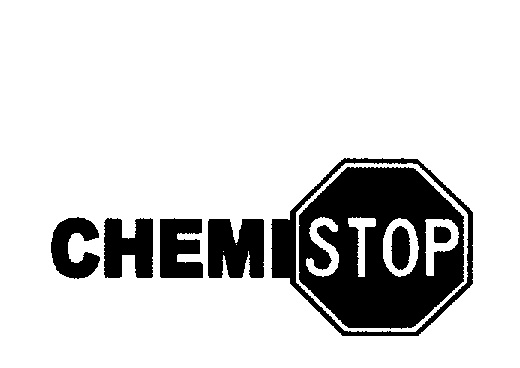
127 Between 2000 and 2001, the Applicants, Messers Sam and Damien Gance and the creative agency developed the following key features for the Chemi Stop stores:
(a) A bright yellow painted shop exterior would be a key feature of the external appearance of the stores to distinguish Chemi Stop from other pharmacies.
(b) The Chemi Stop logo would appear on all the store signage. Initially the words “Chemi” and the first two letters of “Stop” (“Chemist”) appeared in white writing with a black border and the whole of the word “Stop” inside a red octagonal “stop sign” against a blue background. However, in about January 2001 they changed the logo so the word “Chemist” appeared in yellow writing.
(c) There would be a number of “street” signs throughout the store in keeping with the theme of the stop sign used in the logo. For example, at the exit of the store there was a triangular “U-Turn” sign that read “Turn around now for more savings”, and there was a “men at work” sign over the pharmacy’s dispensary.
(d) The colour yellow would be used in conjunction with the colours red and blue (to reference the colours of the Chemi Stop Logo) on the exterior and inside of the store.
(e) A narrow blue band would run along the base of the exterior of the store (the so-called “blue kicker”) referencing the blue background of the Chemi Stop logo and to avoid scuffing or discolouration by passing pedestrians and traffic.
(f) Signage would contain slogans such as “is this Australia’s Cheapest Chemist?”, “low prices guaranteed everyday” which later evolved into “Lowest Price Guarantee” with the words encased in a stamp like device, and “Prescriptions up to 50% Off” which later evolved into “Up to 50% off Prescriptions” and “Stop Paying Too Much” to emphasise Chemi Stop’s branding as a discount pharmacy.
(g) Racking style metal shelving would complement the “traffic theme” and to emphasise the “big box/warehouse” retail concept.
(h) Fragrances would be displayed in wall cabinets as opposed to traditional perfume counters used by other pharmacy stores.
(i) Painted concrete floors and supermarket style aisles which they felt would be consistent with a large warehouse or supermarket.
(j) Supermarket-style signs above each of the aisles would set out product categories.
(k) Front of store supermarket style checkouts would be used (in contrast to standard pharmacies where transactions were typically processed at counters directly in front of the dispensary).
128 An example of the Chemi Stop storefront get-up appeared in a July 2002 catalogue as follows:
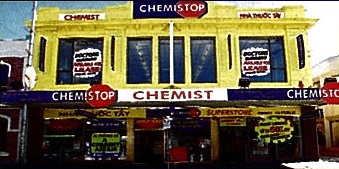

129 The first Chemi Stop store was opened by Mr Damien Gance in Footscray on 15 June 2000. From 15 June 2000 to approximately September 2002, the store traded using the Chemi Stop get-up and logo.
130 At about the same time, the Applicants and Messers Sam and Damien Gance also set up a website (at www.chemistop.com.au) which was used to promote the Chemi Stop business.
131 On or about 4 December 2000, the second Chemi Stop store was opened in Dandenong using the Chemi Stop get-up and trade mark.
132 In April 2001, a story about Chemi Stop was broadcast on Channel Nine’s “A Current Affair”. The story introduced Chemi Stop as “A New Buying System offering consumers up to 50% off their pharmacy bills, both prescription drugs and over the counter items”. The “A Current Affair” program contained footage of how both the outside of the Chemi Stop Footscray and Dandenong stores and the inside of the Chemi Stop Dandenong store looked at that time and key elements of the Chemi Stop get-up such as the yellow building exterior in combination with red and blue, a sign at the store entrance which contained the slogan “Is this Australia’s Cheapest Chemist?” as well as the interior of the Dandenong store showing metal racking style shelves, wide supermarket style aisles and signs containing the words “Stop Paying Too Much”.
133 Commencing in or about October 2000, Chemi Stop circulated monthly catalogues in the local areas for the Footscray and Dandenong Stores. Examples are reproduced below.

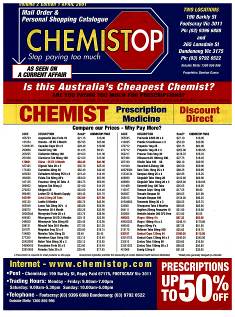
134 At the same time, they also introduced hand written signs throughout the inside of the store on A5 or A7 sized paper containing a Chemi Stop header. The signs were hand written by the staff in the store, to further reinforce the impression of low prices and to convey the temporary nature of the promotional prices.
135 One of their primary objectives in developing the Chemi Stop get-up and selecting its various features was to differentiate Chemi Stop from traditional community pharmacy businesses at the time.
136 In or around mid-2002, the Applicants, and Messrs Sam and Damien Gance began to refine the Chemi Stop concept further, and make changes to the marketing and branding that they considered would be beneficial to the business.
137 In mid-2002, they discussed changing the brand name from Chemi Stop to “Chemist Warehouse”. They decided that the name Chemi Stop was confusing on account of its ambiguous pronunciation and that a simpler name would better convey their retailing concept.
138 At a meeting in or around May 2002 Mr Verrocchi doodled a logo containing a saw tooth roof reminiscent of a warehouse roof, which Messrs Sam, Jack and Damien Gance did not like. He then drew a logo containing the outline of a house with and without a chimney. They discussed whether the chimney made the logo look like a home rather than a warehouse and then agreed to have both concepts mocked up by their graphic designers. Of these, they initially liked the version of the logo without a chimney.
139 On 21 May 2002, the Applicants applied to register the trade mark “Chemist Warehouse” which comprised the logo without the chimney (‘Original Chemist Warehouse Mark’).
140 The Applicants were conscious not to lose any goodwill and brand recognition associated with the Chemi Stop brand, so they decided to slowly transition the Chemi Stop brand name over the 12 months from mid-2002.
141 On the same day as they lodged the application for the Original Chemist Warehouse mark, the Applicants also applied to register a composite trade mark for “Chemi Stop the Chemist Warehouse” using a version of the Chemi Stop logo placed above the Original Chemist Warehouse Mark.
142 In or about mid-2002 they subsequently decided to include a chimney in the “house” logo. They also decided that a red house with a chimney would be used on all Chemist Warehouse signage and marketing materials from then onwards. In September 2002, the first of their transition catalogues was published where the Footscray and Dandenong stores were branded as “Chemist Warehouse — Formerly Chemi Stop”. An example of a transition catalogue is reproduced below.

143 In or about April 2003, the first store branded fully as Chemist Warehouse was opened in Ringwood, Victoria.
144 The Chemist Warehouse business also involved an online presence. Since about April 2003 the Applicants operated an online retail pharmacy at www.chemistwarehouse.com.au.
145 In or about September 2004, the Applicants, together with Mr Sam Gance, Ms Lydia Gance, and Messrs Adrian and Marcello Verrocchi acquired a 50 per cent interest in the online pharmacy business operated by ePharmacy Australia Pty Ltd. That business, including the business at www.epharmacy.com.au, was subsequently merged into a new company— ePharmacy Group Pty Ltd.
146 The get-up of the Virginia, Carseldine, Toowoomba, Townsville and Queensland Chemist Warehouse stores between 2004 and 2006 contained ePharmacy branding as well.
147 From about October 2004 to about 21 May 2006 the Applicants’ (nationally distributed) Chemist Warehouse catalogues directed customers to www.epharmacy.com.au. Nonetheless, Chemist Warehouse maintained a website at www.chemistwarehouse.com.au, however this was not advertised on the catalogues.
148 An example of the Chemist Warehouse website at that time included the following:
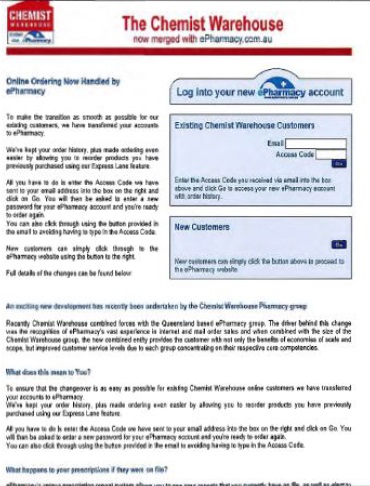
149 Each Chemist Warehouse pharmacy is owned by registered pharmacists (or companies owned by registered pharmacists) trading either alone or in partnership. Those pharmacists in turn collectively form a buying and marketing group. By individual pharmacists pooling their resources together under the Chemist Warehouse banner, they realise the benefits of greater purchasing power by being able to negotiate favourable terms with suppliers for purchasing stock, advertising and marketing, property leases, store fit-out, IT systems and the like. The individual pharmacies either buy product direct from wholesalers or suppliers, as a preferred Chemist Warehouse purchaser, or purchase product from a warehouse partly owned by Mr Verrocchi.
150 In 2014, there were over 110 pharmacists or pharmacist controlled companies, alone or in partnership, who owned the more than 250 stores which trade under licence from the Applicants as Chemist Warehouse. There were 98 in Victoria, 60 in Queensland, 57 in New South Wales, nine in Tasmania, 12 in South Australia, three in the Australian Capital Territory, three in the Northern Territory and 11 in Western Australia.
Reputation at 26 May 2006 (and thereafter)
Store exteriors
151 On 26 May 2006 there were 39 Chemist Warehouse stores nationally. As I have indicated many more stores opened subsequently.
152 I make the following observations about the exterior get-up of the Chemist Warehouse stores as at 26 May 2006, although the observations apply to different degrees to the Chemist Warehouse stores that have opened since that date.
153 The colour yellow features to varying degrees as a background colour in most of the Chemist warehouse storefronts. However, there was no yellow background at the Parramatta or Rundle Mall stores, and a green colour was used above the awning at the Launceston store. Mr Verrocchi acknowledged that, in addition to these stores, the Glen Waverley, Kedron and Fitzroy stores did not have a predominantly yellow exterior. It was also limited at the Elsternwick, Shepparton and Buderim stores. Otherwise, a yellow background was present.
154 The Chemist Warehouse logo of a red house with a chimney and the words “Chemist Warehouse” in capitalised white text within the house is consistent across all stores, with most stores having multiple logos placed throughout the store-fronts.
155 The Chemist Warehouse logo above a blue strip with the words “Discount chemist” in white writing immediately beneath it was present at the Footscray, Dandenong, Ringwood, Geelong, Cheltenham, Toowoomba, Hobart, Mt Gravatt, Box Hill, Wollongong, Windsor (Queensland), Mirrabooka, Hurstville, Fitzroy, Rundle Mall and North Perth stores.
156 The stores also featured a number of slogans including “Up to 50% Off Prescriptions”, “Is this Australia’s Cheapest Chemist?” (where the words “Is this?” were in a smaller text size and oriented at 45 degrees to the remainder of the slogan), “Stop Paying too Much”, “Discount Chemist”, “Never Beaten on Price”, and “Lowest Price Guaranteed” in various colours (not limited to black, white, yellow, red and blue) against various backgrounds. There were also signs (among others) displaying the words “Superstore”, “Discount vitamins”, “Discount cosmetics”, “Direct to public”, “Never beaten on price”, “Sale”, and “Open 7 days”. Other signs contained the Chemist Warehouse website address, indicated opening hours or various discounts on fragrances, directed customers to parking, and displayed ePharmacy branding.
157 The stores often also had price tickets, products, various fluorescent paper signs advertising particular specials or sales, and catalogues in the windows.
158 As a general observation the stores with windows onto the footpath or street had a very busy, cluttered and less uniform appearance at street level, for example the Footscray, Dandenong, Ringwood, Cheltenham, Launceston and Box Hill stores. However, there were some stores which had their windows blocked out with colours (usually yellow) and larger signs.
159 One feature which was consistently presented across the stores in the Chemist Warehouse chain was the Chemist Warehouse logo. During cross-examination, Mr Verrocchi acknowledged that the external get-up of the stores was variable but there would never be a store without a logo. This was the dominant and distinctive feature.
160 The slogans listed above, particularly “Up to 50% Off Prescriptions”, “Is this Australia’s Cheapest Chemist?”, “Stop Paying too Much”, “Discount Chemist”, “Never Beaten on Price”, and “Lowest Price Guaranteed” were also usually present in various combinations and to varying degrees, however, not consistently in the same colour and against the same background. Nor were any of these slogans consistently present such that Chemist Warehouse could establish a reputation for any one or all of them.
161 Mr Verrocchi gave evidence in relation to the exterior get-up of the Chemist Warehouse stores that, notwithstanding the difficulties posed by the different physical limitations of each store, there were certain consistent features of the exterior get-up of each store, namely the use of the primary colours, logo and slogans. However, he did not agree that members of the relevant class of consumers would know it was a Chemist Warehouse store by reference only to the logo (which includes the words “Chemist Warehouse”). As he explained at trial:
Mr Verrocchi: I think [the logo was only] one of the things that referenced the store. The yellow [also] referenced the store. You know, we had comments of “yellow peril.” Like, we had comments, you know, of those sort of descriptions. So I don’t think it was just the logo. The logo is a big part, you know, I’m not denying that. That’s the primary - you know, that’s our primary focus, is the logo, because that’s what a business has, it has a logo. But it has - you know, businesses aren’t just one dimensional, I mean, other than maybe Gap. But, you know, we have a logo which is very strong, red, words “Chemist Warehouse.” Explains what we do. If we get it right, if we put the [words]”discount [chemist]” underneath it as well and so the customer recognises that logo as our place of business. But it also references by colour. Says, you know, well, that yellow box, that yellow building, that yellow chemist shop is where I go and get my goods because I’ve got this fantastic catalogue which has got Panamax for 99 cents and I saw that and then I went for a walk and I saw the yellow building. And once they come once, they’re there. You know, and so…
Mr Clarke: Provided they’re happy?
Mr Verrocchi: Well, provided they’re happy. Hopefully, we make them happy. But my point, you know, goes back to, you know, the conversation we were having, I don’t know, 20 minutes ago and you were - you know, you were saying do they sit down and read it and, once they read the catalogue, they reference it by the logo. That’s probably true in the first instance because it’s new, it’s I’ve never seen this store, I wonder where it is, I wonder what it does. And then they, you know, get off their bums, walk up to the store, walking down, you know, a main street and it’s grey, grey, grey. Bang, there’s a yellow shop. That’s who they are. Wow, I will never forget them in a hurry… And come in, buy their 99 cent Panamax. We tell them how much they save. They get a feel of the store. They get a vibe, you know. As a famous lawyer once said, “It’s the vibe” or a fictitious lawyer. And, you know, they get a feel for the place and that feel stays with them.
Mr Clarke: Yes. Now, the person for the first time doing that from the catalogue, obeying the directions indicated in the catalogue, would be surprised to find a yellow background store, wouldn’t he or she?
Mr Verrocchi: I don’t think they would be surprised. They would be probably - they would say, wow, this is different.
Mr Clarke: Yes, different from what’s…
Mr Verrocchi: It’s a new concept.
Mr Clarke: …indicated in the catalogue?
Mr Verrocchi: I don’t think the catalogues need to look like a shop. I don’t subscribe that point of view.
162 As to the use of yellow by other retailers, Mr Verrocchi observed that in 2000, there were no pharmacies that used yellow, and they “were all pretty bland”. He considered that JB Hi-Fi (which employs a yellow exterior store get-up) may have started around the same time as Chemi Stop. Mr Verrocchi gave evidence that the Applicants were the “first on the block” with yellow, and the initial response of consumers to seeing a Chemist Warehouse store was “surprised, shocked, whatever the word may be, with the yellow and the intensity of the tutti-frutti signage that’s in the store. They will remember that look”.
163 Mr Verrocchi observed further that:
It will be, you know - it will be tattooed in their mind, and next time they’re driving to, you know… jump in the car. I’m going to drive to Rockhampton to go and buy all those drugs that I buy once a month for myself and all my family. There’s a yellow box here in…Emerald. I don’t have to drive to…Rockhampton anymore, because I know that it’s the yellow box. I know that it’s got all the …paraphernalia, and it’s got this red logo. I think it’s one of them. I will go there
164 I accept this evidence with two qualifications. First, with some stores, there were certain features that could not be implemented by reason of planning restrictions or physical limitations, so implementation of Mr Verrocchi’s intended marketing strategy was not always possible or uniform. However, those restrictions or limitations, whilst affecting the intended colouring of the store, did not prevent the use (and the increasingly dominant positioning) of the Chemist Warehouse logo. Secondly, the evidence of Mr Verrocchi is to be read in the context of my earlier observations in relation to the use of the colour yellow, which was in any event but one component of the get-up relied upon by the Applicants in this proceeding.
165 At this stage it is useful to undertake a visual comparison of some of the Chemist Warehouse stores to show the similarities and differences in the get-up across various stores. In doing so, I focus on the get-up prior to 26 May 2006, but my observations apply equally to the other dates on which DCO stores opened.
166 Based on the images of store exteriors in evidence, it appears that as at 26 May 2006, the exterior of most of the Chemist Warehouse stores utilised a general get-up along the following lines.
167 In general, the exterior of buildings which housed Chemist Warehouse stores was coated in a yellow “background”, upon which red and blue colours were used on banners containing slogans, and occasionally to accentuate window and door frames. Banners contained often capitalised “loud” slogans, and slogans in black, red or blue text were often applied directly on the yellow background. This effect created a “cluttered” and “loud” look. The following are examples:
(i) Footscray (2005):
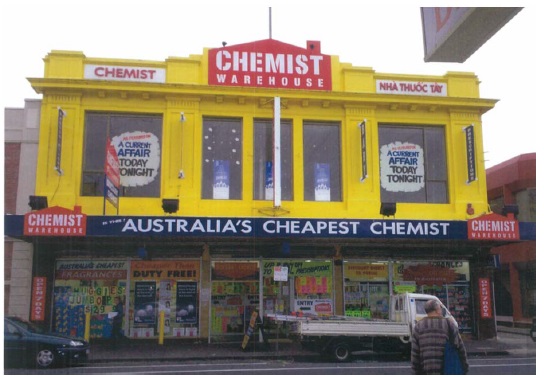
(ii) Carseldine (2005):
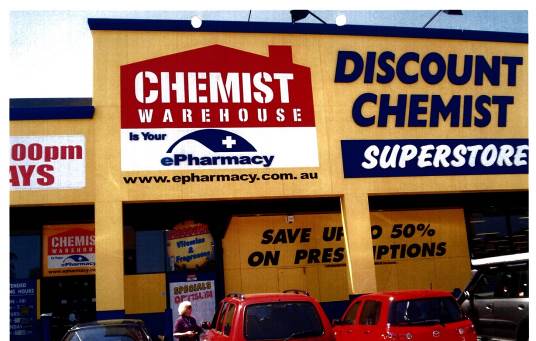
(iii) Frankston (2004):
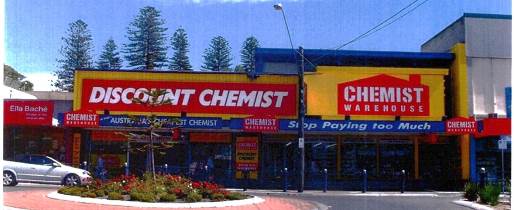
(iv) Mt Gravatt (January 2006):
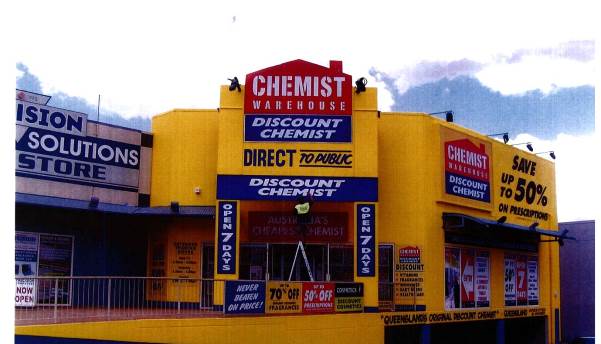
(v) Ringwood (2003):
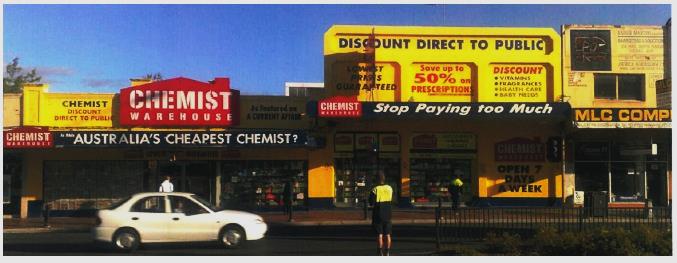
168 In premises where the yellow background could not be used (for example in indoor shopping centres where the storefront was made of glass panes or where regulations may have prevented the coating of the building in yellow paint, storefronts displayed large panels and banners utilising the same yellow background. The following are examples:
(i) Rundle Mall (January 2006):
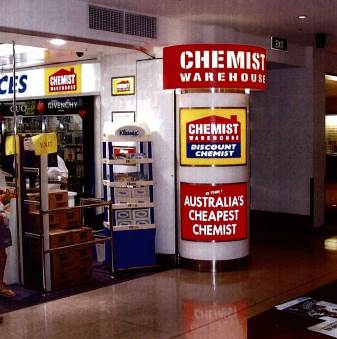
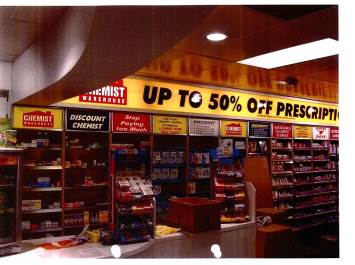
(ii) Fitzroy (January 2006):
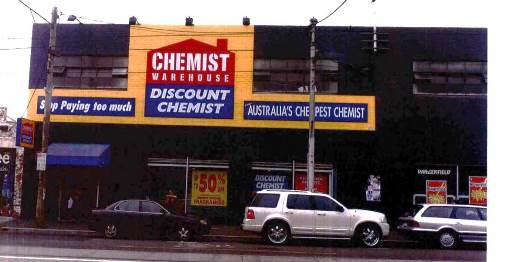
(iii) Mirabooka (2005):
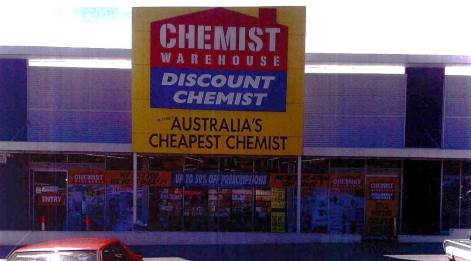
169 Regardless of the “loud” banners and signage, or the prominent use of other colours in the palette such as red or blue, the colour yellow was clearly dominant. The following are examples.
(i) Box Hill (2005), with prominent use of blue and red:
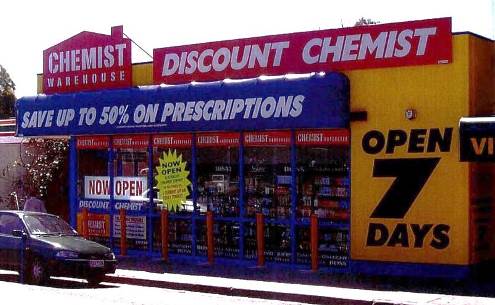
(ii) Kilburn (2004), with prominent use of blue:
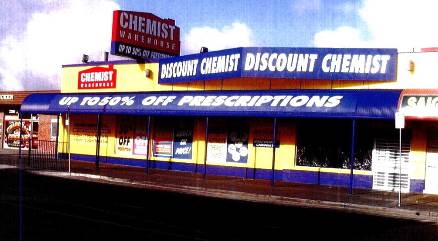
170 Deviations from the above overall impression in evidence were few, and may therefore be seen as exceptions to the application of a general get-up used in Chemist Warehouse’s storefronts. Examples include the following:
(i) Glen Waverley (2005):

(ii) Virginia (2005):
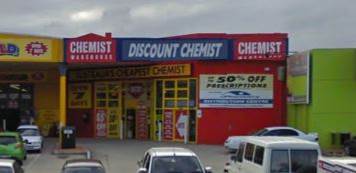
171 The above analysis further supports my observation that the only relevantly distinctive and consistently used branding element in the store exterior get-up was the Chemist warehouse logo. There was also the generally consistent (although not distinctive) use of the primary colour palette.
Store Interiors
172 The interior design and layout of the Chemist Warehouse stores featured elements such as vertical shelf displays of bulk single-brand merchandise, wide aisles, painted concrete floors, bright fluorescent coloured price ticketing containing the Chemist Warehouse logo and inexpensive rack-style shelving.
173 Generally, Chemist Warehouse stores carried the “clutter” and banner-based theme into their store interiors, which was emphasised by high supermarket racking style metal shelving, narrow aisles and an overall “busy” warehouse look.
174 The photographs below, although taken after the relevant date, depict in general terms the overall theme as it existed on 26 May 2006 and thereafter.
(i) Richmond (2014):
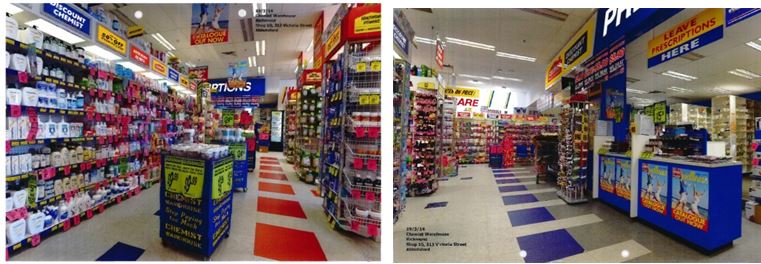
(ii) Kew (2014):
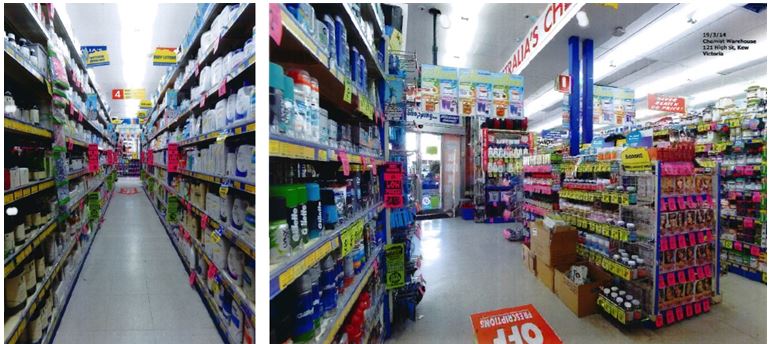
(iii) Oakleigh (2014):
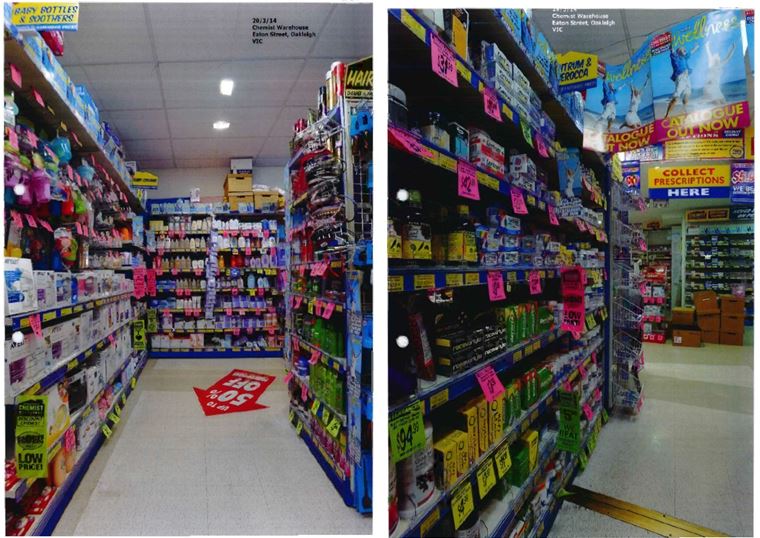
Catalogues
175 Catalogues were the main form of external marketing used by Chemi Stop and Chemist Warehouse. Until at least 26 May 2006, Chemist Warehouse catalogues were distributed as follows:
catalogues were distributed nationally approximately every four to six weeks or so;
between September and December 2002, approximately 100,000 catalogues were distributed;
in 2003, approximately 200,000 catalogues were distributed;
in 2004, approximately 400,000 catalogues were distributed;
in 2005, approximately 1,200,000 catalogues were distributed; and
in 2006, approximately 2,000,000 catalogues were distributed.
176 Mr Verrocchi gave evidence that depending on whether there was a neighbouring store, the distribution area of the catalogues could extend to up to 15 kilometres from the store and, by implication, where there were many stores in close proximity it would not be distributed as far from the stores.
177 There was evidence that Chemist Warehouse catalogues distributed both before and after 26 May 2006 changed in appearance over time. However, each catalogue contained the prominent Chemist Warehouse logo, and the use of the primary colour palette. The layout was not essentially different from what a consumer would normally expect from any typical fast moving consumer goods catalogue.
178 Examples of the Chemist Warehouse and Chemi Stop catalogues distributed from 2000 to May 2006 are included below:
(i) 2004 Catalogue with reference to A Current Affair and Today Tonight:

(ii) 2005 Catalogue using the slogan “Is this Australia’s Cheapest Chemist?” in a style different to the subsequently stylized form which was registered as a trade mark:
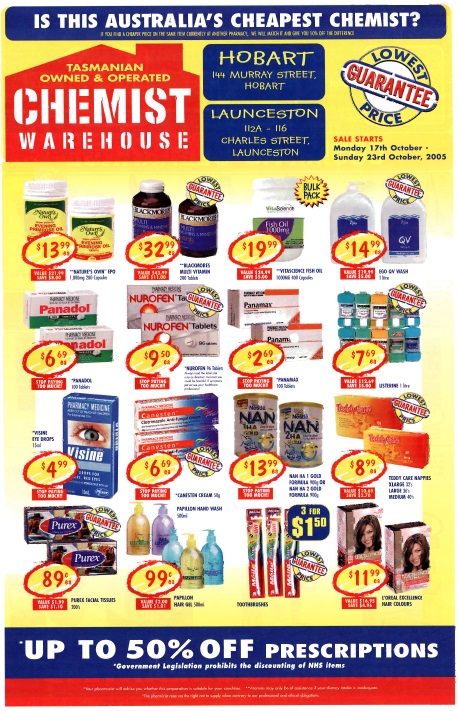
(iii) 2005 Catalogue showing stylised slogan:
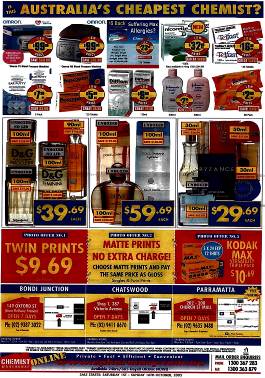
(iv) 2005 Catalogue containing ePharmacy branding:
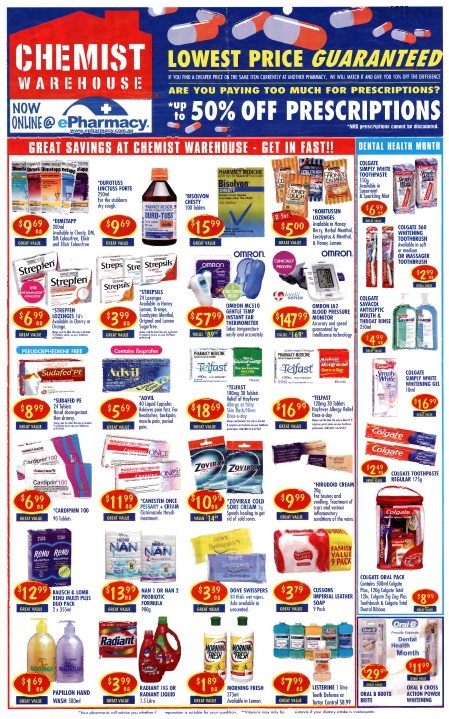
179 A number of things can be said about the Chemi Stop catalogues.
(a) The Chemi Stop catalogues, both before and during the transition to Chemist Warehouse, had a predominantly red and white background (although this was not consistent across all catalogues) and its layout appeared less “busy” in that fewer products were advertised on each page than were typically advertised in Chemist Warehouse’s catalogues.
(b) Some Chemi Stop catalogues were in a large broadsheet format, and others were A4 sized.
(c) In 2002 some catalogues included the words “The Chemist Warehouse” alongside the Chemi Stop logo.
(d) Slogans used in the store get-up were present in the catalogues although they were reproduced in different and inconsistent fonts and colours, and against different background colours.
180 A number of things can be said about the Chemist Warehouse catalogues:
(a) The catalogues indicated the transition from Chemi Stop to Chemist Warehouse in late 2002 via a “Chemist Warehouse” logo in white against a red background, above the words “formerly Chemi Stop” (utilising the Chemi Stop logo).
(b) The catalogues were consistently broadsheet sized.
(c) A Chemist Warehouse logo, displaying the outline of a red house containing the words “Chemist Warehouse”, was usually present at the top or bottom corner of internal catalogue pages from 2003 onwards. The slogan “Stop Paying Too Much” often appeared within the logo above the words “Chemist Warehouse”. Other slogans such as “As Seen on A Current Affair” and “As Seen on Today Tonight” were on occasion placed near the logo or elsewhere on the page. In some catalogues, ePharmacy branding was placed immediately below the Chemist Warehouse logo.
(d) From 2005 a banner extending across the page width was positioned immediately below the Chemist Warehouse logo. The banner contained the words “Is this Australia’s Cheapest Chemist?” often in yellow writing on a blue background. The words “Is this” were in smaller letters than, and oriented at 45 degrees to, the remaining words “Australia’s Cheapest Chemist?”. Prior to 2005, that slogan was also present in the catalogues although not in this uniform style.
(e) There were a number of slogans prominently displayed in various combinations of blue, yellow or white text on blue or yellow backgrounds. Such slogans included “Never beaten on price!!”, “Lowest price guaranteed”, “Up to 50% off prescriptions”, “Stop paying too much for medicines” and “Are you paying too much for prescriptions?”. The slogan which read “Lowest price guaranteed” appeared in nearly all of the catalogues from 2000 with varying fonts, colours and backgrounds.
(f) Product images were often displayed in a grid-like layout, although the size of the grid “cells” (and the associated product images contained therein) varied between and within catalogues.
(g) There was no one dominant colour used. The background colours generally included white, blue, yellow and red, although there were pink and green backgrounds. Often a number of background colours were used on the one page in a catalogue.
(h) Catalogues pages advertised individual products including medicines, vitamins, cosmetics and toiletries. Product images were often displayed in duplicate.
(i) The contact details of, and directions to, nearby Chemist Warehouse stores (sometimes including maps) were displayed towards the bottom of the page and used varying combinations of yellow, blue, red and white text and backgrounds.
(j) Prices were displayed in various ways, although their design consistently utilised the primary colour palette.
181 In my opinion, there were three consistently present features of the catalogues of Chemist Warehouse: the logo, the slogan “Lowest price guaranteed” and use of a primary colour palette. Of these, only the logo was distinctive of Chemist Warehouse. Further, the catalogues looked similar to other catalogues used in retail advertising.
Prescription Price Lists/Mail Order Catalogues
182 Prescription price lists and mail order forms have been printed on behalf of Chemist Warehouse at least twice each year since 2002. Those lists and forms contained prices for the most commonly purchased medications. In addition, whenever a new Chemist Warehouse store opened, a once-off prescription price list was distributed to between 50,000 and 100,000 households in and around the surrounding suburbs nearest to the new store.
Television and radio
183 Chemist Warehouse has advertised on both national and regional television since about late 2002. Most of the television advertisements were run as campaigns throughout the year to support catalogue promotions and were usually broadcast to coincide with national catalogue distribution. It was common for the television advertisements to display the front exterior of a store and the front cover of a catalogue.
184 Chemist Warehouse has also advertised on national and local radio networks since 2003. Radio advertisements were predominantly used to target consumers travelling in their cars, particularly those travelling in the vicinity of a Chemist Warehouse store, who have a prescription to fill or require a product found at pharmacies. Radio advertisements were also used to promote current catalogues and they included some of the Chemist Warehouse slogans such as “Stop Paying Too Much” and “Lowest Price Guaranteed”.
Prescription Backings
185 In or about late 2002, the Applicants designed branded prescription backings (a card to which repeat prescriptions are stapled) incorporating the essential features of the Chemist Warehouse get-up, and these prescription backings have been used by all Chemist Warehouse stores. Those prescription backings which contained the address of a particular store also included a map showing the location of the store and sometimes the words “Look for the Big Yellow Box”.
186 An example of a prescription backing is as follows:

Website
187 There is limited evidence of the Applicants’ reputation in the website up to 26 May 2006. The Applicants registered the domain www.chemistwarehouse.com.au in 2000 and operated an internet pharmacy at that address from about April 2003. They also used the website www.chemistop.com.au from 2000.
188 Extracts in evidence of webpages at www.chemistwarehouse.com.au in the period from 2004 and 2005 (to which I have referred earlier and an example of which is reproduced above) show the use of a white background with the presence of the Chemist Warehouse logo.
189 There is no evidence of web traffic to the Chemist Warehouse website from 2000 to 26 May 2006 and the website design as it appeared in 2014, only came into existence in 2011.
190 The following are examples of the website from 2005 to 2013:
(i) 2009:
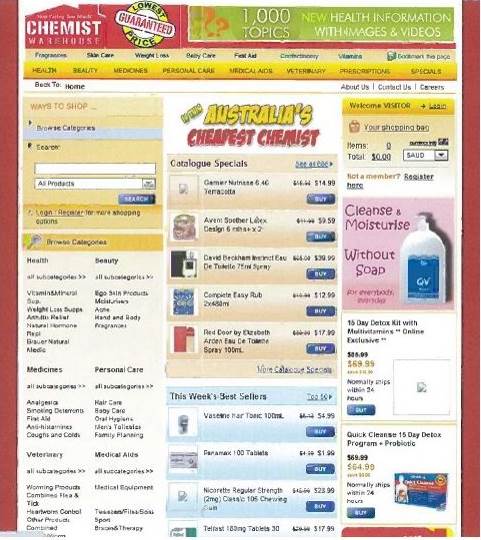
(ii) 2010:
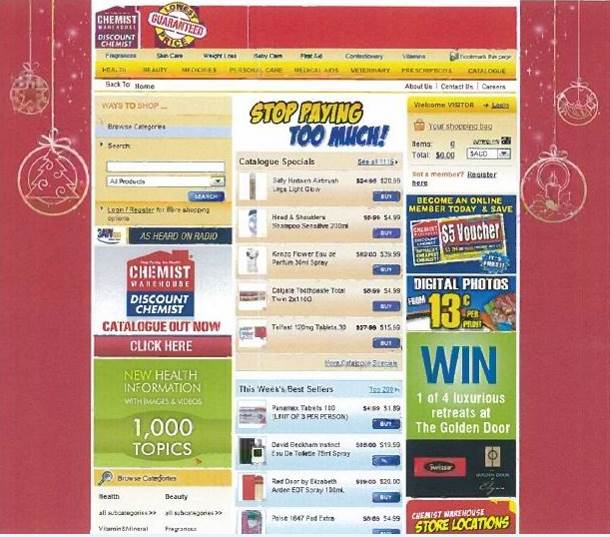
(iii) 2011:
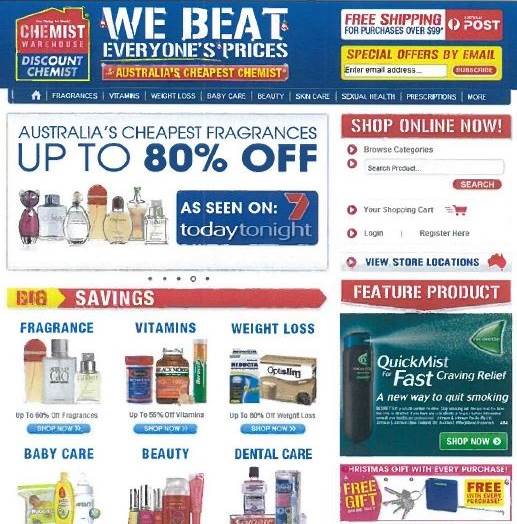
(iv) 2012:
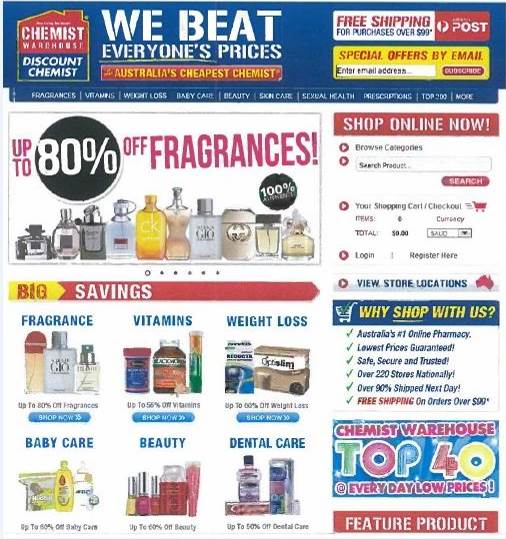
(v) 2013:
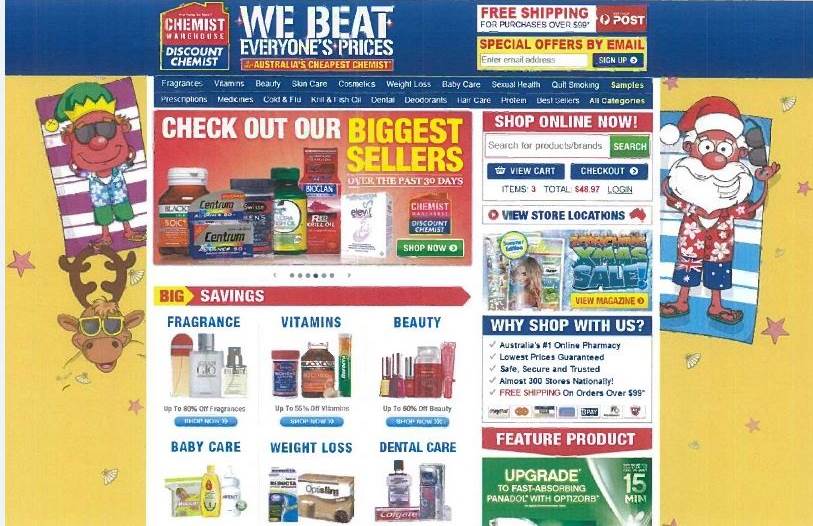
191 The above examples show a lack of consistency over time in the appearance of the Chemist Warehouse website, other than the use of the distinctive logo.
The reach of the reputation
192 Confidential evidence was given by Mr Verrocchi as to the reach of Chemist Warehouse’s reputation. I do not need to detail that confidential information.
193 There is no doubt, that even in May 2006, the discount warehouse chemist concept discussed by Mr Verrocchi had been widely promoted.
194 However, the question in this proceeding concerns the extent to which the get-up relied upon by the Applicants in this proceeding obtained its own distinctive appearance referrable to the Applicants. Further, there is no doubt that since 26 May 2006, and particularly after early 2008, Chemist Warehouse extended its reputation significantly through the opening of many more stores throughout Australia and by other means. It should be noted that Mr Verrocchi acknowledged in cross-examination that in 2008, Chemist Warehouse’s “reach” was significantly weaker than it was when he gave evidence (in 2014).
195 I also note that whilst since 26 May 2006, the reputation of Chemist Warehouse has been enhanced throughout Australia, so too has the reputation of DCO.
196 I now turn to evidence of the relevant consumers’ awareness or recognition of the Applicants’ storefront get-up.
197 Mr Ian Carroll gave evidence on this aspect in this proceeding. Mr Carroll has been the director of CS&G Signs for over two decades providing indoor and outdoor signage services to businesses throughout Australia. Since early 2000, CS&G Signs has provided sign writing services to Chemi Stop and Chemist Warehouse.
198 Mr Carroll gave evidence that in more than half the cases where he was coating the outside of a new Chemist Warehouse store in yellow paint, passers-by queried whether the store was going to be a new Chemist Warehouse, or made comments assuming that it was. He received these queries or comments before he had finished painting the store or installed the Chemist Warehouse logo. This evidence was not challenged in cross-examination.
199 The Applicants contended that Mr Carroll’s evidence supported their submission that there was an association in the minds of the public between a yellow painted pharmacy (it being assumed that the passers-by were at least aware the store was previously or would soon be a pharmacy) and Chemist Warehouse, without the need for other branding.
200 A number of things need to be said about this evidence. As noted above, Mr Verrocchi himself accepted that a number of components were relevant to distinguishing the Chemist Warehouse stores — not just the colour yellow.
201 This proceeding is not simply about the colour yellow and the functional use of yellow in branding.
202 In addition, the evidence needs to be put in context. The random queries of passers-by, who cannot be identified, whilst relevant, do not in my view support the Applicants’ contention.
203 One interpretation of the evidence, without knowing the background of the passers-by, is that they were merely enquiring as to a generic warehouse pharmacy without any association with the Applicants. Further, this evidence may be equated to “survey evidence”, although its basis or methodology is unknown, which affects the ability to draw any satisfactory conclusion as to the likelihood of customers being misled or deceived by the conduct of the Respondent.
204 Further, this evidence may at most show questioning or wonderment by a number of people, but not indicate anything further. The Court does not know what other indicators there may have been suggesting the store was going to be a pharmacy, or what may have prompted the query.
205 In my view, the evidence of Mr Carroll is therefore highly unreliable.
206 Other evidence on consumer reaction was given by two former employees of Mount Waverley DCO (which became a Chemist Warehouse store in November 2013), Mr Theo Kassahun and Ms Ashlen Arevyan.
207 Mr Kassahun, who was the Retail Manager at the Mount Waverley DCO store, between March 2012 and September 2012, gave evidence that on average two customers per day would come into the store with Chemist Warehouse catalogues. Mr Kassuhun explained to such customers that the store was not a Chemist Warehouse store but rather a DCO store. He was authorised by the owners of the store to match the price in the Chemist Warehouse catalogues where DCO would not lose money on the sale. In instances where DCO would lose money on the sale if the price was matched, he would offer a comparable product at a similar or lower price to the one advertised by Chemist Warehouse.
208 Mr Kassahun instructed his sales staff to explain to such customers that the store was a DCO store, not a Chemist Warehouse store, and if a customer became annoyed by this confusion, to refer the customer to Mr Kassahun, or check whether DCO could match the Chemist warehouse price or offer a comparable product for a similar or lower price.
209 Ms Arevyan worked at DCO Mount Waverley as a Dispensary Technician for approximately seven days in or about late May 2012. She gave evidence that during that period approximately six to ten customers came into the store and asked her whether it was a Chemist Warehouse store. Such Customers were often holding a Chemist Warehouse catalogue and enquiring about the products advertised in it.
210 Mr Kassahun and Ms Arevyan were cross-examined as to the motives of the customers with Chemist Warehouse catalogues. Senior Counsel for the Respondents put to them that the reason such customers were entering the DCO Mount Waverley store was that they were trying to take advantage of DCO’s price guarantee, which was advertised on the front of the store in the form of the “lowest price guarantee” sign.
211 The Applicants submitted that the above evidence shows customer “confusion”. This, of course, is insufficient to establish misleading or deceptive conduct, and the background and circumstances surrounding any customer “confusion” in those examples remains unexplained. The Court cannot assume it arose because of the conduct of the Respondents. The conduct of those customers may have been motivated by a hope of price matching, as suggested by Senior Counsel for the Respondents. Further, this evidence related to the circumstances existing in 2012, not May 2006, and in any event, it related only to one particular store. Accordingly, this evidence is not of any weight in determining the issue before the Court.
212 Finally, Mr Damien Gance gave evidence of a conversation he had on 19 February 2009 with Mr Elmo De Alwis, then Managing Director of Sigma Company Limited (the main wholesale supplier to Chemist Warehouse), who mentioned that there was a DCO pharmacy that had opened in Croydon which “looked so similar [to the Croydon Chemist Warehouse] that he had to do a double take”. Under cross-examination, Mr Gance accepted that Mr De Alwis was aware that the store was in fact not a Chemist Warehouse store, and that it was a DCO store.
213 The fact that Mr De Alwis (a person involved in the pharmacy industry and familiar with the Chemist Warehouse get-up) had to do a double take to determine that the store was not a Chemist Warehouse simply indicates that in 2009 the external get-up of the DCO Croydon store exhibited similarities to the get-up of Chemist Warehouse stores. I do not find the evidence of Mr Damien Gance to be supportive of the Applicants’ contentions in this proceeding.
Direct Chemist Outlet
214 I now turn to DCO. At the outset I make a comment upon the issue of deliberate copying.
215 It was put to Mr Tauman throughout his cross-examination that he deliberately copied Chemist Warehouse’s store, catalogue and online get-up with the intention of misleading or deceiving consumers into thinking his stores were, or were associated with, Chemist Warehouse stores.
216 Mr Tauman consistently denied copying Chemist Warehouse’s get-up. He acknowledged that he hesitated in answering some questions because he was concerned his answers may harm his case. He was generally non-responsive in cross-examination to questions concerning the copying of the Chemist Warehouse get-up. Nevertheless, other than on that issue, I have accepted Mr Tauman’s evidence, particularly in relation to the history of DCO and the establishment of the DCO business.
217 I discuss Mr Tauman’s evidence in more detail below. However, as I have explained, evidence of deliberate copying is not necessarily sufficient to attach liability. The evidence of copying must be assessed with other relevant evidence. The focus is on how consumers perceived the DCO business as a result of its get-up and whether as a result they were misled or deceived or likely to be misled or deceived.
218 The failure of the Applicants in this proceeding to show a sufficient consistency of get-up to establish liability on the Respondents cannot be overcome even if deliberate copying was undertaken to the Respondents. In any event, DCO does distinguish itself by its own logo and signage and in my view different get-up, despite the deliberate copying of elements of the Chemist Warehouse get-up.
The history of DCO
219 Mr Tauman graduated from the Victorian College of Pharmacy in 1983. He completed a pharmacy traineeship in 1984 at Amcal Mackie Pharmacy, East Bentleigh. Mr Tauman has been a registered pharmacist for around 30 years.
220 After completing his traineeship Mr Tauman became a locum pharmacist and worked throughout Victoria. He then travelled overseas from 1986 to 1987 and trained and qualified as a pharmacist in London in the United Kingdom with the Underwoods Pharmacy Group (as it was then). This group operated a large number of retail premises in Central London where the dispensary and medicines represented a small proportion of the trade of the business. Unlike pharmacies in Australia, Underwood’s Pharmacy Group sold a wide range of goods including furniture, televisions, sound systems, food and cameras.
221 Mr Tauman returned to Australia in mid-1987 and worked in many local pharmacies in Victoria as a locum manager. He then established his first pharmacy in March 1989 and since the early 1990s had been involved in opening and operating pharmacies primarily in Victoria and Queensland.
222 Mr Tauman called this collection of pharmacies the QVIC Pharmacy Group. QVIC Pharmacy Group Pty Ltd operated the bookkeeping, payroll services and outgoings of those pharmacies.
223 In December 2004 a business partner opened a larger footprint pharmacy via a sublease to the QVIC Pharmacy Group, in Ocean Grove under the Priceline brand. Priceline had entered into the pharmacy market as a franchise model. The concept adopted by Priceline was to take advantage of the growing market in health and beauty products.
224 At this time Priceline was seeking pharmacists to operate a franchised pharmacy with a drug dispensary located at the rear of the store. Priceline stores were directed to the budget end of the market and sought to reinforce the perception of value and their marketing included a popular jingle which included the words “you pay less at Priceline”. Priceline stores required a minimum footprint of 300 m2 which was an increase on the much smaller footprint typical of “local” chemists which was around 150 m2. These larger format stores place a greater emphasis on stocking a large range of items including health and beauty, vitamins, non-prescription medications and products. This required a significant investment in stock, both in terms of the range and volume.
225 Priceline pharmacies started opening in the early 2000s. It was a rapidly expanding business and the franchise was experiencing significant growth. Despite Priceline’s perceived value proposition and discount slogans, it became apparent to Mr Tauman that its retail price points were not competitive in the market place. Franchisees of the Priceline Pharmacy were required to purchase through a single supplier. Mr Tauman was not satisfied with the supplier’s prices and its refusal to sanction the discounting of prescriptions. He was also concerned that Priceline was selling its own “Priceline” brand.
226 Mr Tauman decided to develop a large format pharmacy model similar to Priceline’s perceived value offer which offered a large range of non-prescription items such as health and beauty items, an expanded vitamins range and non-prescription medications provided in large quantities but which combined this with discount medicines and a discount prescription offer.
227 Since around 2002, Mr Tauman had been aware of Chemist Warehouse, and its large format, low service, high volume chemist with the perception of value or low price. He considered that Chemist Warehouse had developed the stores along a similar style as the Bunnings Warehouse model, in that Chemist Warehouse had used large buildings and displayed the generic names “Chemist” and “Warehouse” in a “cargo style” font. He had visited Chemist Warehouse stores and his general impression of those stores was that they gave the impression of value.
228 Mr Tauman made a decision in early 2005 to re-brand the pharmacies that he was operating and launch them in a low cost or discount chemist format. This resulted in a group of pharmacies which would operate under the brand name “Direct Chemist Outlet”. The first DCO store opened in Werribee on 26 May 2006.
229 As at 28 April 2014 there were 24 DCO stores in Queensland, Victoria and New South Wales. The Applicants allege that 25 stores are in issue and this includes the Mount Waverley DCO which was rebranded as Chemist Warehouse in 2013. Furthermore, the Applicants allege the Mount Coolum DCO, which was rebranded as “Mount Coolum Pharmacy” in 2010 and the Merrimbula store which is yet to trade as a DCO are in issue as well.
DCO store exteriors
230 The photographs in evidence showed that the key features of the external get-up were:
(a) The words “Direct Chemist Outlet” positioned on a red half sunburst background, where the words “Direct” and “Outlet” are displayed in blue text with a white outline, and the word “Chemist” in a white and larger sized text (‘DCO Logo’). There were exceptions to this for instance at Werribee, Centro Warrnambool, Mt Coolum, Bittern and Emerald. At Werribee, for instance the words “Direct” and “Outlet” appear in yellow text, and “Chemist” in white text, on a blue background, alongside a red half sunburst containing the slogan “more than just the lowest price”;
(b) The use of various “lifestyle” photographs of pharmacists or customers posing against yellow, blue and red backgrounds;
(c) The use of a yellow, red and blue colour palette;
(d) The presence of the words “Discount Chemist” in various coloured text and against various coloured backgrounds usually displayed near the DCO Logo;
(e) The presence of vertical merchandise boxes at the front of the stores; and
(f) The display of slogans such as “Save” and “Save up to 50% off prescriptions”, “Why pay more?”, “More than just the lowest price”, and the words “Lowest price guarantee” in a circular blue and white logo accompanied with a tick, against a red background.
231 The most recognisable features of the exterior get-up are the DCO Logo, the words “Discount Chemist” and the lifestyle photos. Those features are eye catching and identify the store as a DCO store. There is an absence of consistency in the various text and background colours used. However, the DCO stores mostly use the same colour palette as that used by Chemist Warehouse.
232 It is again useful to make some observations on the DCO store exteriors by reference to some photographs.
233 The images in evidence show that DCO stores employed a general store exterior get-up along the following lines.
234 Most storefronts used a primary colour palette, and some had a yellow background, similar to that of Chemist Warehouse. In addition to this colour theme, most store exteriors prominently displayed lifestyle photographs, often individually set against gradient backgrounds of red, yellow or blue. Examples include the following:
(i) Rosebud:
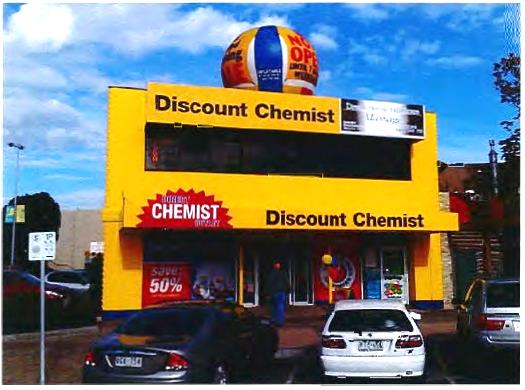
(ii) Croydon:
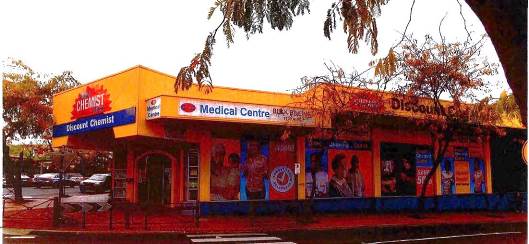
(iii) Werribee:
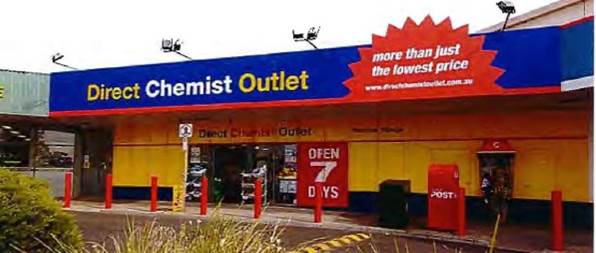
(iv) Central West:
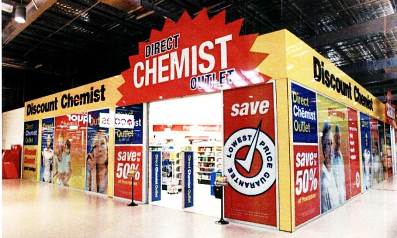
(v) Warrnambool:

235 Other stores, especially those located in shopping centres, used some yellow signage, although the relatively consistent use of lifestyle photographs and the primary colour palette were the dominant features.
(i) Bayswater:
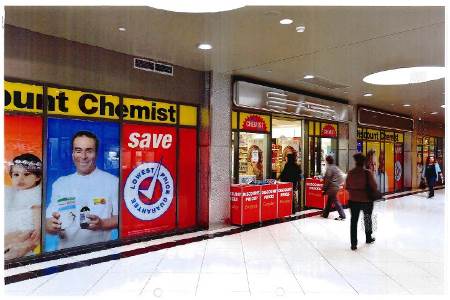
(ii) Somerville Centro:
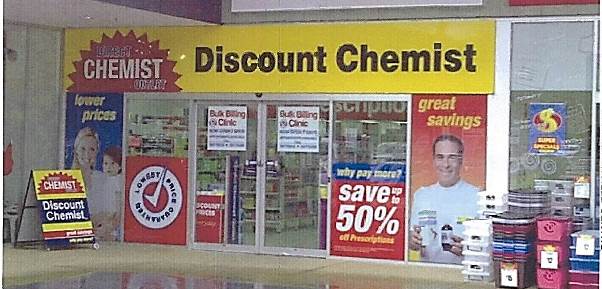
(iii) Somerville West:
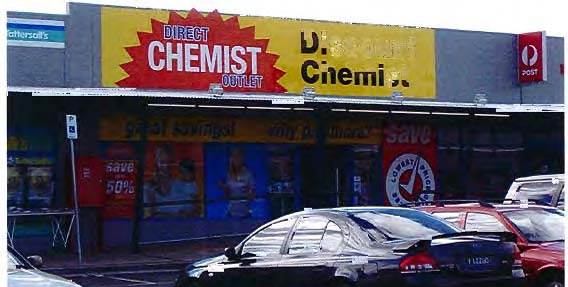
(iv) Tura Beach:
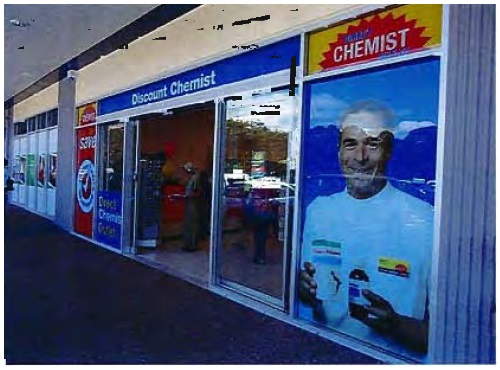
(v) Koo Wee Rup:
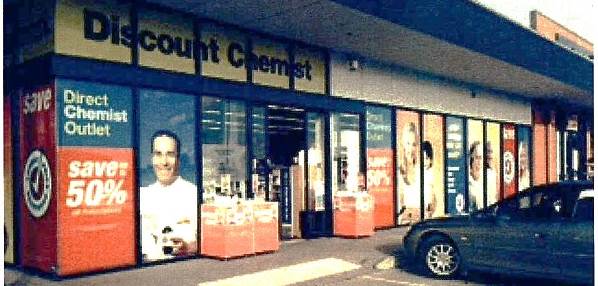
236 There were more exceptions to the general DCO theme than was shown with the Chemist Warehouse theme, however either the primary colour palette, or the lifestyle photos were present in all stores.
(i) Emerald:
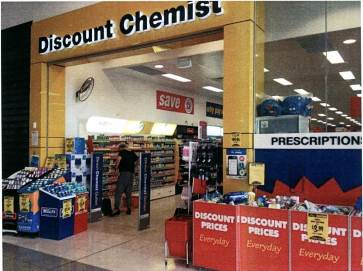
(ii) Bega:
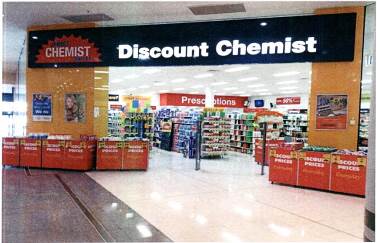
(iii) Mt Coolum:
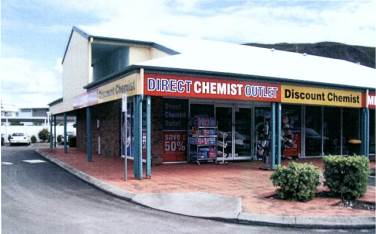
(iv) Bittern:
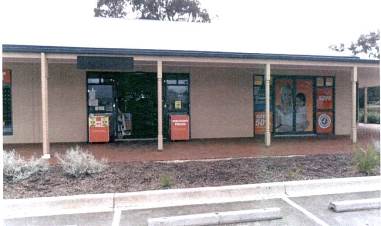
(v) Centro Warrnambool:
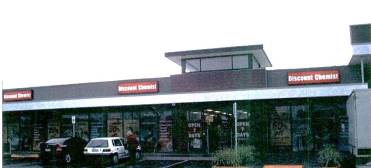
237 I pause here to make an observation in relation to the colour palette used by both DCO and Chemist Warehouse.
238 Whilst comparison of the minutiae of the Chemist Warehouse get-up with the DCO stores’ get-up might reveal further similarities or differences, such a detailed comparison is not useful in assessing the likelihood that consumers would be misled or deceived. The appropriate and relevant comparison must be made at a reasonably general level, without over-intellectualising. In my view, the appropriate comparison reveals the following general points.
239 Whilst the images in evidence highlight the consistent use of yellow in Chemist Warehouse stores, they do not of themselves establish that there was a consumer association of the colour yellow alone with Chemist Warehouse or a reputation of such. In any event this was not contended for by the Applicants.
240 Although both Chemist Warehouse and DCO used a primary colour palette in their store exteriors, this is not a sufficiently distinctive element of the get-up. As the Respondents submitted, and as I mentioned above, many businesses in various industries (including pharmacy) use a primary colour palette in their storefront get-up, and especially the colour yellow, most probably for the simple reason that yellow, blue and red contrast particularly well with black or white writing, and with each other. Further, Mr Verrocchi conceded in cross-examination that primary colours were “very obvious contrasting colour combinations” for any retailer seeking to grab attention or communicate that their products are low priced.
241 Examples of other businesses using a similar colour palette include:
(i) Cincotta Discount Chemist:
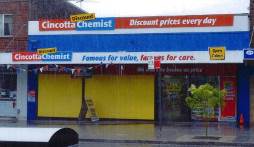
(ii) My Chemist:
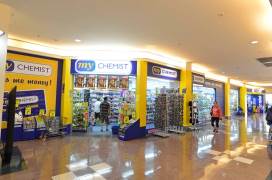
(iii) Wholesale Pharmacy:
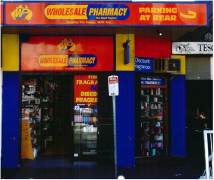
(iv) Bob Jane T-Marts:

242 In comparing the two storefront get-ups of the parties, I also observe the following. Chemist Warehouse storefronts were consistently “loud” and “cluttered” with slogan bearing banners. In contrast, DCO storefronts were not as cluttered. The use of banners was often limited to the words “Discount Chemist”, which was not capitalised. Where the yellow background was used on DCO stores, large sections of the yellow background were often left bare, giving a cleaner appearance. The following are examples of these differences:
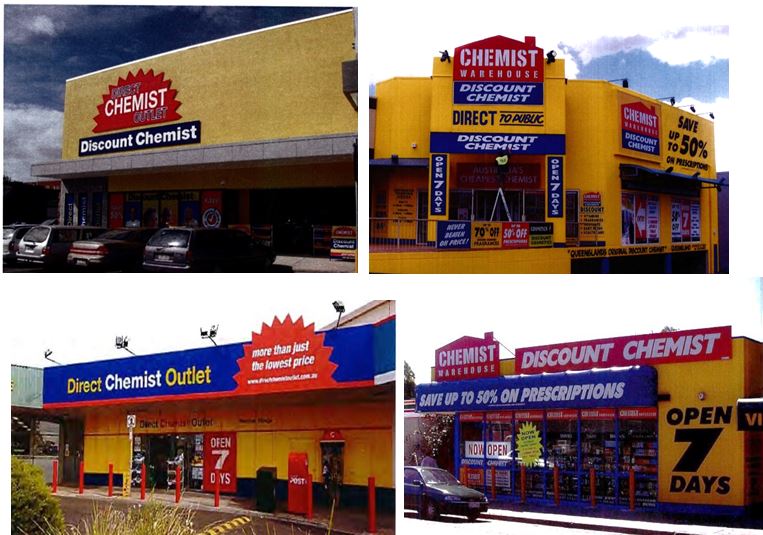
243 DCO store exterior get-up utilised the distinctive and prominent lifestyle photos element relatively consistently, which was not a feature of Chemist Warehouse’s get-up.

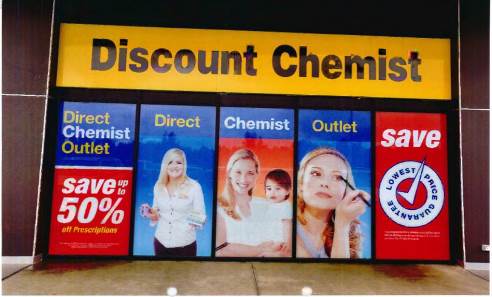
244 Put simply, setting aside the colour theme and logos, Chemist Warehouse’s store exterior get-up could generally be characterised as cluttered and banner-based, whereas DCO’s storefront get-up could be characterised as cleaner and lifestyle photo based. At the relevant general level, these are different get-ups.
DCO store interiors
245 The internal get-up consisted of fluorescent price tickets, vertical merchandise displays, rack style shelving and discount bins, and vinyl flooring. The medicine dispensary area of the stores is usually identified by a “prescriptions and advice” sign in white text on a red background.
246 It is again useful to look at some photographs.
247 DCO store interiors had a relatively cleaner appearance than Chemist Warehouse stores through the use of lower shelving typical of common retail pharmacies, slogans in sentence case, and consistent red and white “prescriptions and advice” and “please pay here” signage. Examples of DCO store interiors are reproduced below:
(i) Bittern:
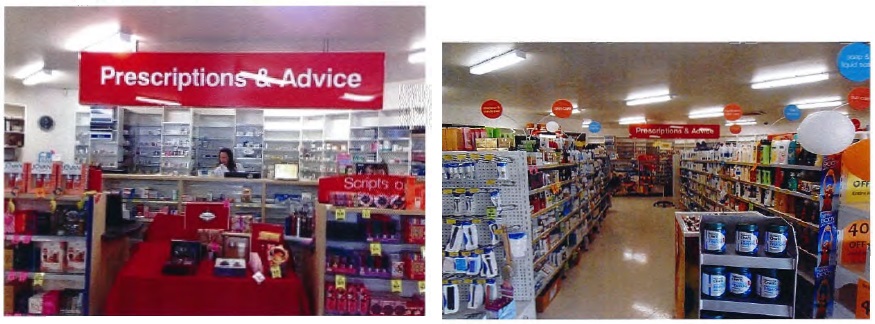
(ii) Rosebud:
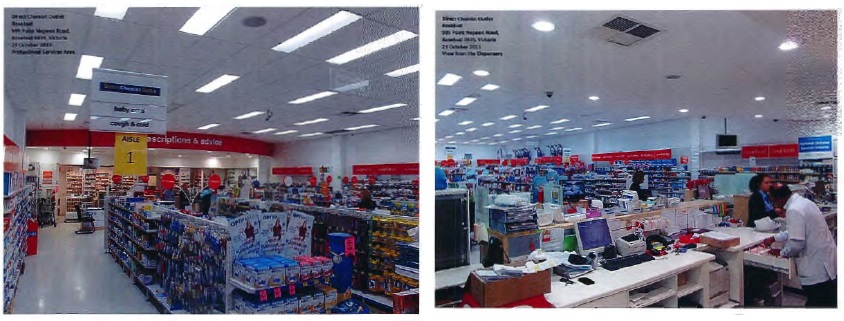
(iii) Tura Beach:
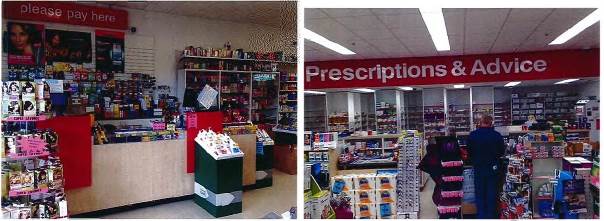
(iv) Central West:
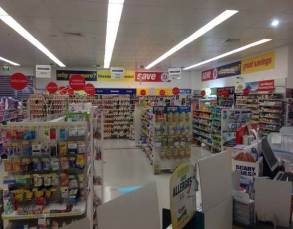
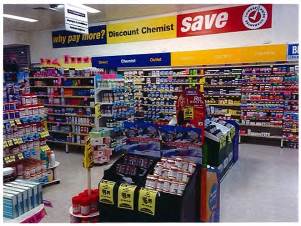
248 In contrast, the Chemist Warehouse store interiors (examples of which are included above) employed a very different get-up and gave a different impression with higher shelving, narrower aisles, and a general “warehouse” atmosphere. In my view, consumers would not be confused when inside a DCO store, let alone misled or deceived into believing, that there was an association with Chemist Warehouse. That said, I have mentioned earlier that the interior get-up is not as important as the exterior get-up in the context of this proceeding.
Catalogues
249 The first DCO catalogue was distributed in August 2006.
250 DCO distributed catalogues with a similar frequency to Chemist Warehouse — a minimum of 11 catalogues were distributed each year. In 2006, approximately 100,000 copies of each edition were printed. This has since grown to around 200,000 copies per edition.
251 Catalogues were distributed generally within a three kilometre radius of DCO stores although in some circumstances they were distributed more broadly. For example, the catalogue for the Emerald store was distributed to Blackwater which is approximately 77 km away. In general however, the greater the population density the smaller the distribution radius.
252 Two examples of catalogues distributed in 2006 are reproduced below:
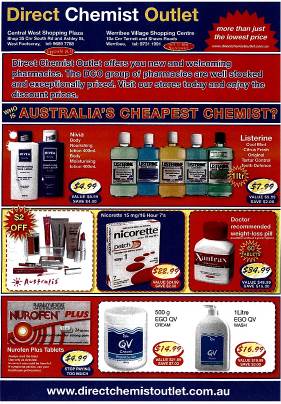
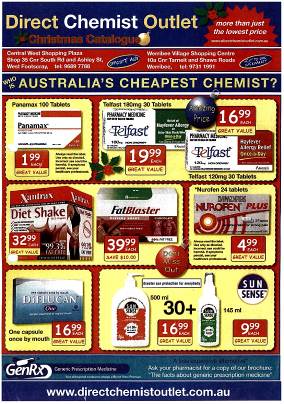
253 DCO catalogues have changed since the first edition, however the following observations can be made:
(a) It was consistently printed in a broadsheet format similar to that of Chemist Warehouse’s catalogues.
(b) Between the first catalogue and approximately March 2008 the top of most pages contained a blue banner with the words “Direct Chemist Outlet” (“Direct” and “Outlet” in yellow text and “Chemist” in white), a red half sunburst shape containing both the slogan “more than just the lowest price” and the DCO web address.
(c) Subsequently, this was replaced with the DCO Logo (which as described above, contained the red half sunburst element) and the words “Discount Chemist” in black text against a yellow background.
(d) A blue banner was consistently included at the top and base of each page.
(e) Catalogues displayed the slogan “Who is Australia’s Cheapest Chemist?” with the words “who is” in smaller letters than, and oriented at 45 degrees to, the remaining words “Australia’s Cheapest Chemist”. Prior to 2008, the slogan appeared close to the top of the front page, and from at least March 2008 it appeared under the DCO Logo and usually against a blue background (DCO ceased using this slogan when this proceeding commenced).
(f) Products were arranged on each page in a grid and individually bordered with a dashed line, against backgrounds of red, yellow and blue.
(g) Since 2009 there had been an “information page” discussing health issues.
254 The key features were the half sunburst logo in red, the words “Discount Chemist Outlet” and “Discount Chemist”, and the “Who is Australia’s Cheapest Chemist?” slogan as described above. Since at least March 2008 the header of the catalogue has become essentially uniform, with the main difference to this arrangement being that the “Who is Australia’s Cheapest Chemist?” slogan was less dominant, and more recently, non-existent.
255 Again I observe that while in many respects the catalogues changed in appearance over time, the distinctive logo has been consistently present. I also observe that in taking the time to read a catalogue and search out bargains, a consumer would be likely to pay close attention to some of the detail in the catalogue, and would certainly pay attention to the branding and logo to ascertain the particular retail outlet that is offering the desired product and price.
Website
256 DCO had a website when the Werribee and Central West stores opened, however no record as to what it looked like was tendered into evidence.
257 The web address of the DCO group is www.directchemistoutlet.com.au. This website is registered to QVIC Pharmacy Group Pty Ltd and is used by DCO.
258 It is not possible to conduct sales through www.directchemistoutlet.com.au. The website is used to provide information about the DCO group and has included copies of current catalogues, information about the group and store contact details. It has also included a similar header to the catalogue (the DCO Logo and the words “Discount Chemist” in black text against a yellow background) and has displayed images showing store interiors and DCO staff.
259 Mr Tauman did not until recently consider the website to be an important part of the business, however I note that the web address was displayed in the half sunburst logo on the Werribee store since 2006. No evidence was tendered as to the amount of web traffic it attracted.
260 An example of the website of the Respondents as it appeared in 2012 is as follows:
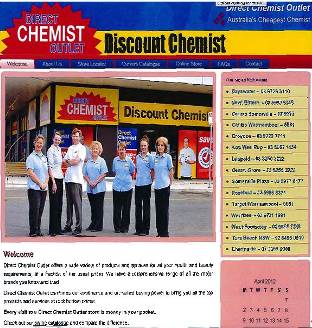
EVIDENCE OF COPYING
261 I return to Mr Tauman’s evidence and the issue of copying. The Applicants submitted that the Court should be reluctant to accept or give much (if any) weight to Mr Tauman’s written or oral evidence (especially to the extent that it involves his opinion, speculation or conclusion) that is not supported by independent evidence. They further submitted that where Mr Tauman’s evidence conflicts with that of another witness, those other witnesses’ evidence should be preferred.
262 The Applicants point to a number of instances, which they view as evidence that Mr Tauman copied the Chemist Warehouse get-up.
263 For example, they submitted that he was unwilling to concede the “obvious” references to the Chemist Warehouse get-up, trying to deflect the origins of his get-up onto references to unrelated traders, such as Bob Jane T-Marts, the look of which was not similar to the DCO get-up as the get-up of Chemist Warehouse and was for an entirely unrelated market (not discounting and not pharmacy).
264 Mr Tauman in his evidence maintained that he chose the colours (yellow, blue and red) because they were “the best colours for retail and discounting” rather than accepting that he used the colours that were already known and associated with Chemist Warehouse.
265 Mr Tauman was aware of Chemist Warehouse from 2002 and its use of a yellow, blue and red colour scheme. He acknowledged that DCO branding used the same “Reflex Blue” and red “Pantone 485” colours as Chemist Warehouse, but pointed to the fact that the same red colour was also used by Priceline. With respect to Priceline, Mr Tauman said that it was permissible to copy design features of Priceline and that his model adopted many of Priceline’s features.
266 Mr Tauman also gave evidence that he took pictures of the Chemist Warehouse store in Virginia as part of an unrelated planning dispute with Chemist Warehouse in 2005 and provided the pictures to a designer, Mr Troy Mendham, whom he retained to design the Werribee storefront.
267 It is to be observed that Mr Mendham also reviewed the get-up of other businesses in undertaking work for Mr Tauman, including Amcal Max, Windjet, DFO, Bob Jane T-Marts, Crazy John’s, Supercheap Auto, Kmart, Foodworks, Reflex, Bunnings Warehouse and Australia Post Office Supplies.
268 However, it seems clear to me that Mr Tauman eventually decided to copy the approach taken by Chemist Warehouse in the get-up of its stores. This is not to say that Mr Tauman was not influenced by the approach of other businesses in relying on the use of primary colours (including yellow) in their branding, for the reasons I have already outlined.
269 With respect to the DCO catalogues, Mr Tauman said that he did not know if he was responsible for the copying of a yellow “swish” which appeared on some 2011 DCO catalogues from the Chemist Warehouse catalogues and then continued to avoid answering questions directly:
Mr Golvan: If you look at MV4 tab 1. Yes, you see the swish that appears under the word “everyone’s”; this is showing you now the Chemist Warehouse catalogue dated March 2012?
Mr Tauman: I can see the swish and…
Mr Golvan: And you’ve derived it from – your usage of it is derived from Chemist Warehouse, isn’t it?
Mr Tauman: I don’t put the catalogue together, Mr Golvan.
Mr Golvan: But you’re responsible for the publication of the catalogue, aren’t you?
Mr Tauman: I take responsibility for the work that’s done.
270 However, the evidence of Ms Jenna Rohr, who was Group Coordinator for the DCO stores with responsibility for catalogue production, was that Mr Tauman suggested using a yellow swish similar to one featured in a Chemist Warehouse catalogue along with the use of the “Gunplay” font used.
271 The above evidence concerning the DCO catalogues relates to conduct in 2011 and 2012. It is therefore not directly relevant to Mr Tauman’s state of mind at the time the Werribee DCO store first opened. However, it does assist in establishing whether there was a pattern of behaviour.
272 Mr Damien Gance gave evidence that on 19 February 2009, Mr Tauman had told him that Mr Tauman had taken the best parts of Chemist Warehouse and copied them to develop the design, look and feel of the Croydon DCO store. This evidence was confirmed and not challenged in cross-examination. Mr Tauman’s evidence was that he told Mr Damien Gance that he had taken features from a range of different retailers. Both aspects are probably correct — I am sure Mr Tauman did copy the “best parts” of the Chemist Warehouse concept, but this is not to say that he did not draw inspiration from the features of other retailers.
273 I will deal later with the Respondents’ use of the slogan “Who is Australia’s Cheapest Chemist”. It does bear a striking resemblance to the “Is this Australia’s Cheapest Chemist” slogan present on Chemist Warehouse stores and catalogues as at 26 May 2006. This is another indication of copying by Mr Tauman.
274 As I mentioned above, Mr Tauman was evasive in his response to questioning on copying. Nevertheless, my own impression is that he was an honest witness, but wanted to downplay the extent to which he copied the marketing ideas of Chemist Warehouse.
275 Whilst I am satisfied that Mr Tauman may have drew some inspiration from other retailers, it is clear that he was heavily influenced by, and copied elements of, the Chemist Warehouse get-up. Further, it is likely that Mr Tauman, who was aware of Chemist Warehouse’s use of a primary colour palette, chose a similar palette for the same reason as the Applicants had, namely that is that it is eye catching and associated with value, the success of which he saw demonstrated (for example) in Chemist Warehouse’s case.
276 Whilst concluding that Mr Tauman copied elements of the Chemist Warehouse get-up, I do not find that he did so fraudulently. In my view, he saw a number of good marketing ideas which he thought he could legitimately copy, and he implemented them. I do not conclude he intentionally sought to create a perceived association between DCO and Chemist Warehouse. In fact, I think he wanted to do the exact opposite. Despite the comments I have made about Mr Tauman and his evidence, I accept that his aim was to establish and develop his own discount chemist brand in direct competition with Chemist Warehouse. This is consistent with his background, the events leading up to his development of the DCO business model, and his subsequent conduct.
CONCLUDING OBSERVATIONS ON MISLEADING OR DECEPTIVE CONDUCT
277 I make these brief final observations.
Stores
278 Putting aside my earlier comments on the inconsistent get-up of the Chemist Warehouse stores, there were distinguishing features of the DCO stores in any event. The key distinguishing features of the DCO stores were the DCO Logo and the use of lifestyle photos on the store exterior. The shape of the red half sunburst in the logo was in my view particularly distinctive and recognisable.
279 I interpolate by saying that this is reinforced in the catalogues where the words “Discount Chemist Outlet” and the DCO Logo or red half sunburst was the distinctive feature which catches the eye. Although the blue banner certainly contributed to the get-up used in the catalogue, it did not contribute as much as the DCO Logo to the overall impression of DCO’s get-up (for example, across catalogues, storefronts and online).
280 Whether one is looking at a Chemist Warehouse or a DCO store, the relevant consumers are more concerned with the identity of the store by reference to its logo than by any other feature of the get-up. In my view, if a person does not identify the logo, he or she does not identify the store to be a Chemist Warehouse store, or a DCO store for that matter.
281 The function of the get-up of a storefront (other than promoting its goods or services) is to distinguish the particular store brand from that of others, especially competitors. In my view there are relevant differences between the appearance of the DCO and Chemist Warehouse storefronts as I have detailed throughout these reasons.
Catalogues
282 The same can be said of the catalogues. Any reputation which Chemist Warehouse derived from, or is referrable to, its activities, was a reputation in the Chemist Warehouse logo. There were no other features of the catalogues which were distinctive of Chemist Warehouse. The colours, words and layout used were used only in a descriptive, functional or ornamental manner. For instance, the slogan “Lowest Price Guaranteed” can hardly be seen as distinctive.
283 Recipients of Chemist Warehouse catalogues who wished to purchase an advertised item may, or may not, have taken their catalogues with them to the store. However, they generally would have arrived at the relevant Chemist Warehouse store by reference to the address details on the catalogue, or would have otherwise been familiar with its location. In either case, the catalogues entreat consumers to visit a Chemist Warehouse store, identified by the Chemist Warehouse logo.
284 There are some similarities between the DCO and Chemist Warehouse catalogues, namely the grid-like arrangement of products, the prominent use of the primary colour palette and the use of the slogan “who is / is this Australia’s Cheapest Chemist?”. However, the overall impression of the catalogues is different. In any event, to a certain extent all retail catalogues have similar features.
285 In my view, and consistent with what I have found above, the relevant consumers would not be misled or deceived by the DCO catalogues into thinking that either DCO was, or was associated with, Chemist Warehouse.
Website
286 I have already found that the Chemist Warehouse website lacked a distinctive or consistent appearance, and underwent significant changes in appearance over time.
287 To the extent there is relevant evidence, in my view the websites of the parties differed greatly in design, and each website clearly drew attention to the logo and identity of the particular brand. I cannot envisage the relevant consumer being “confused”, and certainly not misled or deceived, by the DCO website.
TRADE MARK VALIDITY AND INFRINGEMENT
288 The Applicants are the registered owners of the following trade mark in respect of “Retailing, online retailing and mail ordering services; all relating to pharmacies” in class 35 and “Medical, hygienic, beauty care services all relating to pharmacies; all of the foregoing being pharmacy advisory and pharmacy dispensary services” in class 44:

289 The trade mark was registered without limitations as to colour, and is therefore taken to be registered for all colours: s 70 of the TM Act. The application for registration was filed on 28 August 2007.
290 DCO has used the slogan (displaying the words “Australia’s Cheapest Chemist” prominently and, in smaller letters, the words “Who is”) on catalogues and prescription backings. The first usage was in DCO’s August 2006 catalogue, where it appeared as follows:

291 Subsequently, from at least December 2006 the catalogues published by Mr Tauman and after its incorporation, DCO, contained the slogan below (ie yellow text on a blue background) until at least March 2009 when it appeared in white writing on a blue background, before changing again in October 2011. From October 2011 to July 2012, the phrase was displayed in the “Gunplay” font in white text on a red background before changing back to a sans serif font in the same colours.

292 Other changes have occurred since July 2012, which require no elaboration for the purposes of these proceedings. However, the Respondents stopped using the slogan prior to trial.
Validity
293 I have reached the conclusion that the Applicants’ mark is not valid, as it does not fall within either s 41(5) or s 41(6) of the TM Act.
294 The Applicants accept that at the lodgement date the trade mark was only to some extent inherently adapted to distinguish the designated services as those of the Applicants. To that end, s 41(3) of the TM Act does not apply to the analysis of validity.
295 Turning to s 41(5) of the TM Act, as I have already indicated, the question of inherent adaptation to distinguish is properly considered by reference to the following question, as stated by Stone J in Kenman Kandy:
[161]…the question is whether if the [appellant’s mark] were to be registered as a trade mark, other persons trading in [the same market] and ‘being actuated only by proper motives’ would think of this [mark, or a sign that is substantially identical with, or deceptively similar to, the mark] and want to use it in connection with their goods in any manner that would infringe the appellant’s trade mark.
296 Justice Stone went on to articulate a “subsidiary and difficult question” in cases where the mark (in that case, a bug shape) “has associations that deprive it of the inherent capacity to distinguish the appellant’s [product] from that of other traders”: at [161].
297 For similar reasons, a descriptive or non-distinctive word cannot be inherently adapted to distinguish. Likewise, minor variations on such a word cannot be protected by trade mark registration, because to grant such a monopoly would create trade mark infringers of others who make other ordinary “deceptively similar” use of that word.
298 For example, the last three and dominant words of the Applicants’ trade mark, “Australia’s Cheapest Chemist”, contain three separate parts signifying geographical location, price and nature of business respectively. Neither of these, whether viewed independently or combined, have the required distinctiveness.
299 If the words “is this” are simply added to that non-distinctive phrase and receive trade mark protection, a person using as a trade mark the ordinary words “Australia’s Cheapest Chemist” would be infringing the trade mark. This leads to the conclusion that the Applicants’ trade mark is invalid, following the reasoning of Stone J in Kenman Kandy.
300 In these circumstances s 41(5) cannot be satisfied.
301 In relation to s 41(6) of the TM Act, the Applicants contended that before the filing date of 28 August 2007, they had used the mark consistently and extensively as a trade mark to distinguish the Applicants’ services from those of others, which meant it had in fact become distinctive as at that date. In particular, they submitted that the mark had appeared (with minor variations which did not substantially affect the identity of the mark):
(a) prominently on the awning, walls or windows of a majority of Chemist Warehouse storefronts since 2002, and that by the lodgement date there were 60 Chemist Warehouse Stores around Australia;
(b) on most Chemist Warehouse catalogues since October 2005, and in 2006, approximately two million catalogues had been distributed every four to six weeks to locations extending to about a 15 kilometre radius of the Chemist Warehouse stores (which number of catalogues distributed has substantively since increased);
(c) in television advertisements aired prior to the lodgement date; and
(d) in promotional material in Women’s Day in 2006, a nationwide publication with a readership of over 2.5 million readers.
302 It is established that extensive use in itself is not enough. The mark must be “a reliable badge of trade origin on its own”: see, eg, Unilever Australia Ltd v Societe Des Produits Nestlé SA (2006) 154 FCR 165 at [36] per Bennett J.
303 It is worth mentioning that the significance of the Applicants’ trade mark was often diluted by the dominant logo and other slogans of a similar nature which surrounded it or appeared nearby on stores, catalogues and the website, which affects any distinctiveness garnered from extensive use: see, eg, Chocolaterie Guylian NV v Registrar of Trade Marks (2009) 180 FCR 60 at [97] per Sundberg J.
304 More importantly however, as I stated above, the Applicants’ trade mark contains predominantly descriptive words and is not relevantly distinctive. The extensive use of that mark by the Applicants does not make it distinctive. As Jacob J stated in British Sugar plc v James Robertson & Sons Ltd [1996] RPC 281 at 302:
There is an unspoken and illogical assumption that ‘use equals distinctiveness’. The illogicality can be seen from an example: no matter how much use a manufacturer made of the word ‘Soap’ as a purported trade mark for soap the word would not be distinctive of his goods…. It is precisely because a common laudatory word is naturally capable of application to the goods of any trader that one must be careful before concluding that merely its use, however substantial, has displaced its common meaning and has come to denote the mark of a particular trader. This is all the more so when the mark has been used in conjunction with what is obviously taken as a trade mark.
305 In these circumstances s 41(6) cannot be satisfied. I conclude that the registered mark is invalid.
Infringement
306 Although unnecessary to decide, for completeness I will address the infringement claim. To some extent the arguments relating to validity and infringement overlap.
307 I have reached the conclusion that the Respondents have not used the sign complained of as a trade mark.
308 The Applicants submitted that the Respondents’ use of the slogan “who is Australia’s Cheapest Chemist?” was “as a trade mark” and is therefore captured by s 120 of the TM Act. They pointed to the fact that Mr Tauman accepted that he sought to register the phrase “Who is Australia’s Cheapest Chemist?” as a trade mark and in fact used it on his DCO catalogues and website in a strikingly similar manner to that of the Applicants.
309 In addition, the Applicants made the following submissions:
(a) The Respondents’ use of the sign is deceptively similar because persons would be caused to wonder whether there was a link between the registered proprietor of the mark (the Applicants) and the Respondents. The diminutive words “Is this” in the registered trade mark will necessarily take a minor role in the assessment of deceptive similarity, though their presence cannot and should not be discounted. Similarly, the words “Who is?” or “Who is” as used in the phrase adopted by the Respondents will be given less significance (in the sense of meaning as opposed to visually) and would, when read, simply highlight the conceptual similarity between the phrases. The marks denote the same idea and are used in respect of exactly the same services and in the same way, with the angled introductory words.
(b) The phrase poses a question and is plainly not a statement of fact. As such, the phrase is not purely descriptive but elicits an engagement with the consumer that is at least to some degree unusual and unexpected.
(c) The phrase is not a natural question that a properly motivated pharmacist would wish to pose as at the lodgement date. In the assessment of inherent distinctiveness of the mark, it cannot be said that the Respondents are an example of another trader acting without improper motive.
310 It is important to understand the context in which this issue arises. Both Chemist Warehouse and DCO are discount chemists. It follows that the comparatively lower price of their goods, or the consumer perception of it, is of paramount importance to their businesses. Both Mr Verrocchi and Mr Tauman indicated that they wanted Chemist Warehouse and DCO respectively to be known as Australia’s cheapest chemist. They are direct competitors and compete on price.
311 According to both parties, the discount chemist business model had been in existence since the early 2000s. Importantly, that model could be served by a number of possible phrases such as “Lowest Prices”, “Crazy Prices”, “The Lowest prices in Australia”, “Australia’s Lowest Chemist Prices” and “the Good Price Pharmacy”.
312 In fact, DCO (like Chemist Warehouse) has used other slogans which convey a similar message, including “unbeatable prices” and the descriptor “discount chemist”, on occasion in combination with the slogan, as depicted below:
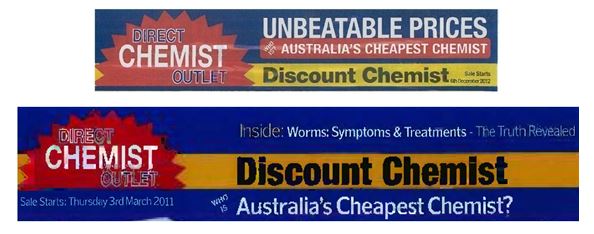
313 Like the surrounding slogans, the “Who is Australia’s Cheapest Chemist?” slogan conveys the implication that it operates, and competes, in a category of discount (or “cheap”) chemists. It is understandable and common for any discount chemist to ordinarily seek to covey such messages of cheapness in its marketing materials.
314 I do not consider that the Respondents used the slogan as a trade mark. As I stated above, the inquiry is whether consumers see the sign as “a reliable badge of trade origin on its own”. For the reasons outlined above in relation to validity, such a trade mark is merely descriptive and is not sufficiently distinctive to be used “as a trade mark”.
315 On this basis there was no infringement because the Respondents have not used the sign complained of as a trade mark.
WHETHER MATTER SHOULD BE TRIED BY JURY
316 Prior to this matter being heard but after being set down for hearing, I indicated that I thought that this might be an appropriate matter to be tried by a jury and I invited submissions. Both parties opposed the matter being tried by a jury. I ordered that the proceeding continue to be tried by a judge alone. Below are the reasons for that approach.
317 Section 40 of the Federal Court of Australia Act 1976 (Cth) (the ‘Act’) provides that:
The Court or a Judge may, in any suit in which the ends of justice appear to render it expedient to do so, direct the trial with a jury of the suit or of an issue of fact, and may for that purpose make all such orders, issue all such writs and cause all such proceedings to be had and taken as the Court or Judge thinks necessary, and upon the finding of the jury the Court may give such decision and pronounce such judgment as the case requires.
318 However, s 39 of the Act provides that “[i]n every suit in the Court, unless the Court or a Judge otherwise orders, the trial shall be by a Judge without a jury.” This has led Rares J to observe in an extra-curial paper (Justice Steven Rares, ‘The Jury in Defamation Trials’ — paper presented at the Defamation & Media Law Conference — Sydney, 25 March 2010, 4–5) that the Act provides for trial by jury in “exceptional cases” where the policy in s 39 “informs but does not overwhelm the exercise of the discretion to order a trial by jury.”
319 Justice Northrop in Insurance Commissioner v Australian Associated Motor Insurers Ltd (1982) 65 FLR 172 at 182 held that, before a judge directs a trial with a jury, some “substantial reason” must be shown for a departure from the normal method or mode of trial. His Honour cited Fullagar J in McDermott v Collien (1953) 87 CLR 154 (‘McDermott’) who, when refusing to direct a trial by jury said, at 157:
…But, so far as any question of general policy is involved, it is settled for me by the High Court Procedure Act. Trial without a jury is the normal mode of trial of actions in this Court, and some special reason must be shown for a departure in any particular case from that normal mode. The second thing that seems clear is that it is not enough to show that the cause of action is of a kind which could quite properly be tried with a jury and which was normally tried with a jury in England before the Judicature Act 1873 (36 & 37 Vict. c. 66). The decisions of Hodges J. and of Isaacs J. perhaps suggest that the nature of the cause of action is not even a relevant consideration. I would not be prepared to assent to that as a general proposition: indeed I would rather have thought that it might in some cases be a potent consideration. But it is clear that it is not enough to say: “This is a kind of action which is quite suitable for trial with a jury, and I would like to have it tried with a jury.
320 Ultimately, Northrop J concluded (at 184) that he was not “persuaded that the ends of justice appear to render it expedient that this suit should be tried by judge and jury.”
321 As Bromberg J observed in Comcare v John Holland Rail Pty Ltd (2010) 189 FCR 173 (‘Comcare’) at [15], various Judges of this Court have either followed or referred (with approval) to Fullagar J’s holding “that trial without jury is the normal mode of trial and that some special reason must be shown for a departure”. Justice Bromberg in that case (at [21]) rejected a contention that there is no usual mode of trial in the Federal Court, and stated that it was “manifest that an applicant for departure from the norm bears a burden…to establish that, in relation to the suit in question, the ends of justice render it expedient to depart from the norm”: at [22].
322 However, Bromberg J held that the burden was not necessarily onerous. His Honour went on to explain:
[23] When Fullagar J in McDermott said that “some special reason must be shown for a departure...from the normal mode” his Honour was not using the phrase “special reason” to characterise the gravity or weight of the burden involved. Read in context, Fullagar J was using “special” to distinguish the reason from the ordinary or usual reasons utilised in support of jury trials in the age-long debate as to whether, as a general policy, jury trials are preferable to trials by judge alone.
[24] In the passage in which that phrase occurs, Fullagar J makes it abundantly clear that the “general policy” question of whether civil jury trials are better than judge alone trials is not a matter for him. As his Honour said, that was a matter “settled for me by the High Court Procedure Act” by providing that trial without a jury is the normal mode of trial. It is in that context that Fullagar J said some “special reason” must be shown to justify a departure from the norm. His Honour had in mind the identification of a reason which transcended the general policy debate, and the usual reasons utilised in that debate, to justify a general preference for civil jury trials over trials by judge alone.
[25] Whilst the judicial discretion conferred by s 40 is wide, the discretion is not a vehicle for resolving case by case, the age-old debate as to whether universally the ends of justice are better served in a civil cause by a jury trial or by a judge alone. As a matter of general policy, some judges will prefer judge alone trials while others will prefer jury trials. But the general policy has been determined by Parliament and is not to be redetermined in the exercise of the discretion conferred by s 40. A reason which is universally applicable to all trials as a reason in favour of jury trials generally, or a reason universally against trials by judge alone, will not, without more, constitute a reason for the exercise of the discretion. This is the sense in which the need to show a “special reason” should be understood.
[26] A majority of the New South Wales Court of Appeal took a similar approach when considering the proper exercise of a judicial discretion to order a trial without a jury, where the norm was a jury trial: see Pambula District Hospital v Herriman (1988) 14 NSWLR 387 at 402 per Kirby P and 413 per Samuels JA. Likewise, the New South Wales Court of Appeal rejected reliance upon universally applicable reasons in favour of jury trials, in construing a discretion similar to that conferred by s 40 of the Federal Court Act: Maroubra Rugby League Football Club Inc v Malo [2007] NSWCA 39 (further discussed below).
[27] John Holland’s contention, that all that is necessary is that the Court be satisfied that a trial by jury is expedient for the ends of justice, ignores the starting point from which the discretion is to be exercised. Section 40 confers a discretion to decide whether the ends of justice render it expedient to resile in a particular case from the general policy enshrined in s 39, that the usual mode for trial is by judge without a jury. A special reason, in the sense I have described, will ordinarily be required for the Court to be satisfied that the ends of justice appear to render it expedient that a trial by jury be ordered.
(emphasis added)
323 I am unaware of any case that has concerned an allegation of misleading or deceptive conduct or passing off that has been determined by jury in the Federal or any Supreme Courts, save for the one instance referred to in the following paragraph.
324 The only occasion where the Federal Court (Justice Rares) ordered a trial by judge and jury was Ra v Nationwide News Pty Ltd (2009) 182 FCR 148 (‘Ra’) which predominantly involved a claim of defamation. Justice Bromberg in Comcare (at [38]–[39]) observed the following regarding Ra:
[38] …Rares J was satisfied that the critical issues in the proceeding before him were quintessentially better determined by a jury, not by reference to an inherent characteristic of juries of universal application, but by reference to a peculiar advantage that a jury trial brought to the particular kind of case there at play. The peculiar advantage was identified in the following passage:
[19] One of the great virtues of having a jury try the substantial factual issues in a defamation action is that they represent the very audience to which the defamatory publication was addressed. In assessing whether or not a publication, first, is defamatory in the sense complained of and, secondly, has been defended under defences such as truth, honest opinion or fair report, a jury of ordinary reasonable people is able to evaluate the competing factual issues bringing to bear the moral and social standards that they share with the community at large. And, they are better placed than judicial officers to assess how ordinary reasonable people understand mass media publications.
[39] Additionally, the facts in Ra were unusual and were likely to involve giving effect to contemporary moral and social values of the community. In that case it was alleged that defamatory imputations were made against the applicant, including that she was a brothel owner and madam who kept foreign women as sex slaves.
325 It was on the basis of the concepts addressed by Rares J in Ra that consideration was given to the option of a jury trial. Questions of fact, to be determined by reference to consumers, needed to be addressed by the Court. After all, whether conduct is misleading or deceptive, or likely to mislead or deceive, is “a quintessential question of fact. A common lawyer would call it a jury question”: Australian Competition and Consumer Commission v Telstra Corporation Ltd (2004) 208 ALR 459 [49] per Gyles J.
326 Nevertheless, I considered that the normal mode of trial was appropriate. A significant factor was that all parties opposed a trial by jury. The parties also pointed to a number of practical considerations. Foremost was the fact that at the time that consideration was given to this issue, the trial was listed for an estimate of a seven day hearing. Interlocutory steps had been undertaken on the basis that a judge alone would hear the proceeding. There is no doubt that, as a practical matter, the introduction of a jury would invariably have added a significant further cost and preparation burden to the parties.
CONCLUSION
327 In light of the foregoing reasons, the application should be dismissed, and the cross-claim allowed with appropriate consequential orders. In normal events, costs would follow the event.
328 I propose to order that, by 4.00 pm on 27 March 2015, the parties confer and file and serve a joint minute of orders reflecting these reasons (including as to costs), or in the event of disagreement, a separate minute of order with short written submissions in support thereof.
|
I certify that the preceding three hundred and twenty-eight (328) numbered paragraphs are a true copy of the Reasons for Judgment herein of the Honourable Justice Middleton. |
Associate:




